

Compact Muon Solenoid
LHC, CERN
| CMS-HIG-20-006 ; CERN-EP-2021-189 | ||
| Analysis of the CP structure of the Yukawa coupling between the Higgs boson and $\tau$ leptons in proton-proton collisions at $\sqrt{s} = $ 13 TeV | ||
| CMS Collaboration | ||
| 10 October 2021 | ||
| JHEP 06 (2022) 012 | ||
| Abstract: The first measurement of the CP structure of the Yukawa coupling between the Higgs boson and $\tau$ leptons is presented. The measurement is based on data collected in proton-proton collisions at $\sqrt{s} = $ 13 TeV by the CMS detector at the LHC, corresponding to an integrated luminosity of 137 fb$^{-1}$. The analysis uses the angular correlation between the decay planes of $\tau$ leptons produced in Higgs boson decays. The effective mixing angle between CP-even and CP-odd $\tau$ Yukawa couplings is found to be $ -1 \pm 19 ^{\circ}$, compared to an expected value of $ 0 \pm 21 ^{\circ}$ at the 68.3% confidence level. The data disfavour the pure CP-odd scenario at 3.0 standard deviations. The results are compatible with predictions for the standard model Higgs boson. | ||
| Links: e-print arXiv:2110.04836 [hep-ex] (PDF) ; CDS record ; inSPIRE record ; HepData record ; CADI line (restricted) ; | ||
| Figures & Tables | Summary | Additional Figures & Tables | References | CMS Publications |
|---|
| Figures | |

png pdf |
Figure 1:
The decay planes of two $\tau$ leptons decaying to a single charged pion. The angle ${\phi _{{\textit {CP}}}}$ is the angle between the decay planes. The illustration is in the H rest frame. |

png pdf |
Figure 2:
The normalised distribution of ${\phi _{{\textit {CP}}}}$ between the $\tau$ lepton decay planes in the H rest frame at the generator level, for both $\tau$ leptons decaying to a charged pion and a neutrino. The distributions are for a decaying scalar (CP-even, solid red), pseudoscalar (CP-odd, dash blue), a maximal mixing angle of $45^{\circ}$ (CP-mix, dash-dot-dot green), and a Z vector boson (black dash-dot). The transverse momentum of the visible $\tau$ decay products $ {p_{\mathrm {T}}} ^{\tau}$ was required to be larger than 33 GeV during the event generation. |

png pdf |
Figure 3:
Illustration of the $\tau$ lepton decay planes and the angle ${\phi _{{\textit {CP}}}}$ for various decay configurations. The decay planes are illustrated with the shaded regions, and either the vector ${\hat{\lambda}}$ or the momentum vector of the neutral pion is in the decay plane. The illustrations are in the frame in which the sum of the momenta of the charged particles is zero. Left: the decay plane for the decays $\tau^{-} \to \pi^{-} +\nu $ and $\tau^{+} \to \pi^{+} +\bar{\nu} $. Middle: the decay plane as reconstructed from the neutral and charged pion momenta. Right: ${\phi _{{\textit {CP}}}}$ for the mixed scenario, in which one $\tau$ lepton decays to a pion while the other decays via an intermediate $\rho$ meson. |
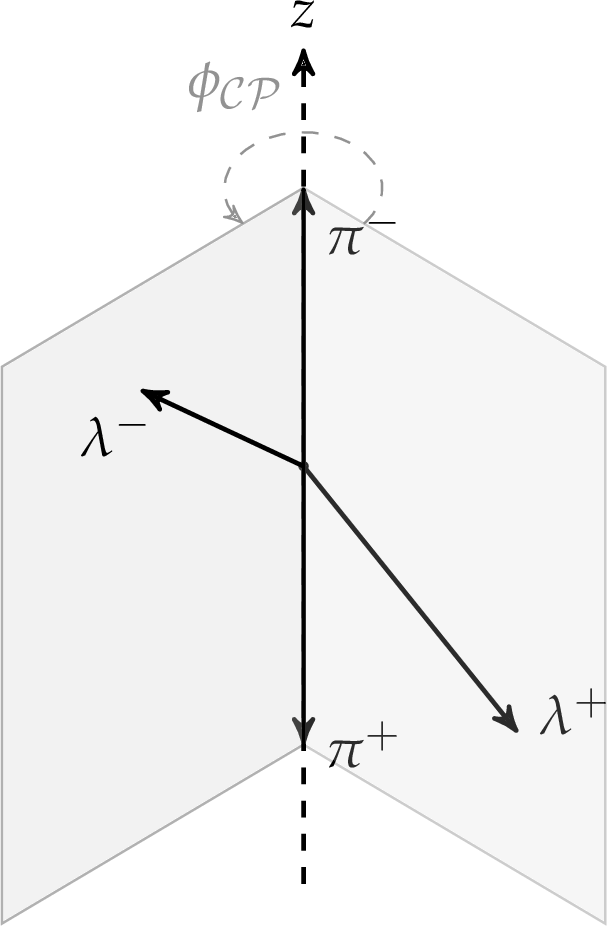
png pdf |
Figure 3-a:
The decay plane for the decays $\tau^{-} \to \pi^{-} +\nu $ and $\tau^{+} \to \pi^{+} +\bar{\nu} $. |
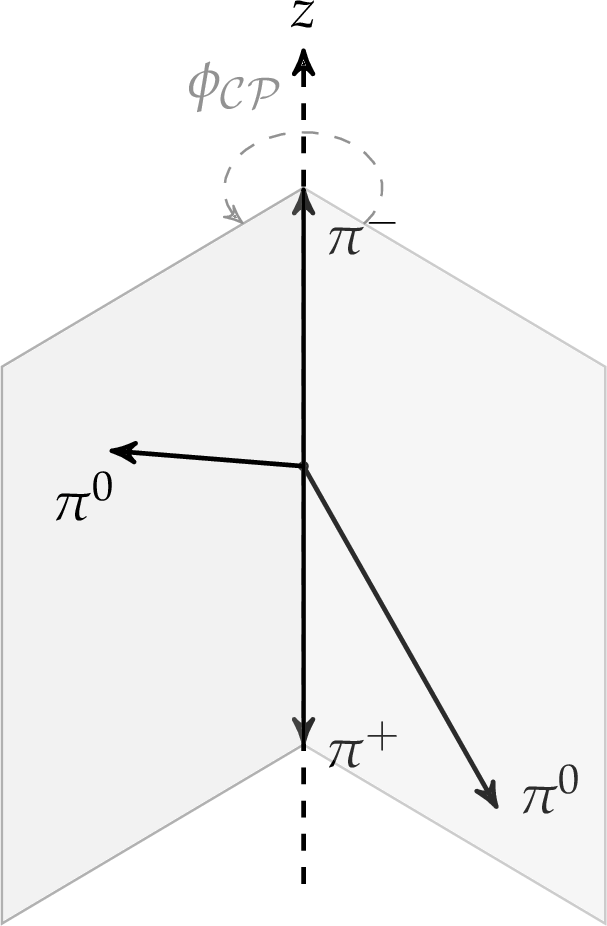
png pdf |
Figure 3-b:
The decay plane as reconstructed from the neutral and charged pion momenta. |

png pdf |
Figure 3-c:
${\phi _{{\textit {CP}}}}$ for the mixed scenario, in which one $\tau$ lepton decays to a pion while the other decays via an intermediate $\rho$ meson. |

png pdf |
Figure 4:
The decay of ${\mathrm {a_{1}^{3\text{pr}}}}$ via an intermediate ${\rho ^0}$ to three charged pions. |

png pdf |
Figure 5:
The angle ${\phi _{{\textit {CP}}}}$ for ${\mu \to {\tau _\mathrm {h}}}$ events in which the ${\tau _\mathrm {h}}$ decays to a charged $\pi$ (upper) or a charged $\rho$ meson (lower). The distributions are decomposed in a subset in which the charged $\pi$ is "nearly coplanar" (left) or "nearly perpendicular" (right) to the production plane. |
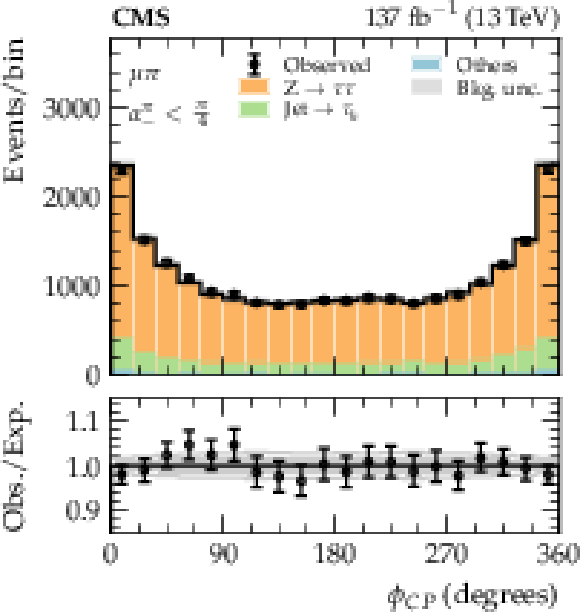
png pdf |
Figure 5-a:
The angle ${\phi _{{\textit {CP}}}}$ for ${\mu \to {\tau _\mathrm {h}}}$ events in which the ${\tau _\mathrm {h}}$ decays to a charged $\pi$. In this subset the charged $\pi$ is "nearly coplanar" to the production plane. |
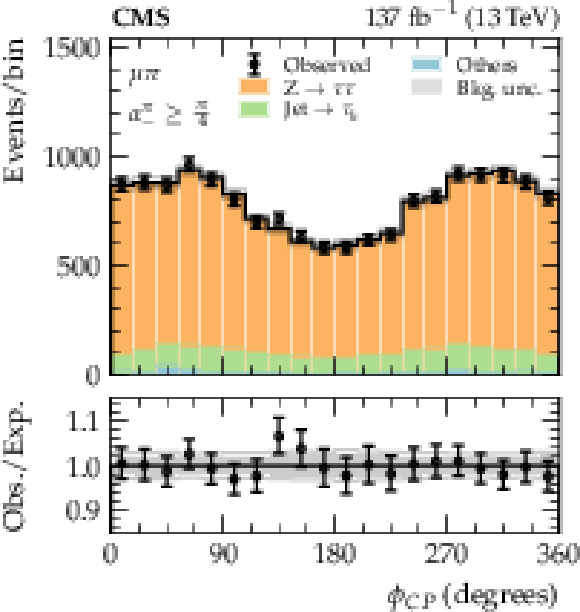
png pdf |
Figure 5-b:
The angle ${\phi _{{\textit {CP}}}}$ for ${\mu \to {\tau _\mathrm {h}}}$ events in which the ${\tau _\mathrm {h}}$ decays to a charged $\rho$ meson. In this subset the charged $\pi$ is "nearly perpendicular" to the production plane. |

png pdf |
Figure 5-c:
The angle ${\phi _{{\textit {CP}}}}$ for ${\mu \to {\tau _\mathrm {h}}}$ events in which the ${\tau _\mathrm {h}}$ decays to a charged $\pi$ (upper) or a charged $\rho$ meson (lower). The distributions are decomposed in a subset in which the charged $\pi$ is "nearly coplanar" (left) or "nearly perpendicular" (right) to the production plane. |
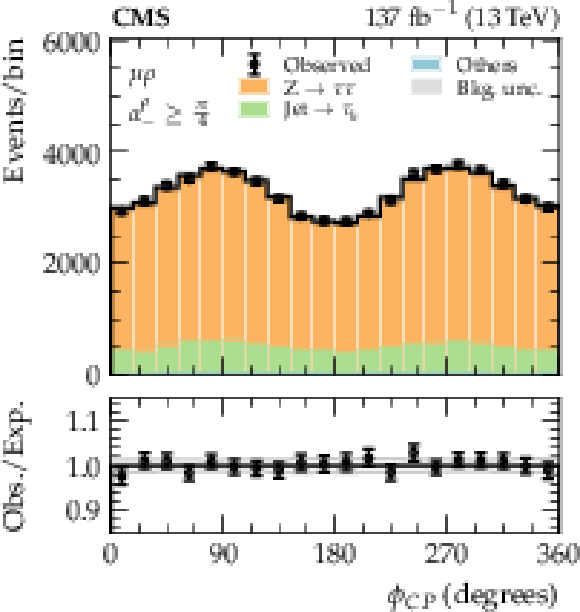
png pdf |
Figure 5-d:
The angle ${\phi _{{\textit {CP}}}}$ for ${\mu \to {\tau _\mathrm {h}}}$ events in which the ${\tau _\mathrm {h}}$ decays to a charged $\pi$ (upper) or a charged $\rho$ meson (lower). The distributions are decomposed in a subset in which the charged $\pi$ is "nearly coplanar" (left) or "nearly perpendicular" (right) to the production plane. |

png pdf |
Figure 6:
The post-fit MVA score distributions for the Genuine (left) and Mis-ID categories (right) in the ${\tau _{\mu} {\tau _\mathrm {h}}}$ (upper) and ${{\tau _{\mathrm{e}}} {\tau _\mathrm {h}}}$ (lower) channels. The distributions are inclusive in ${\tau _\mathrm {h}}$ decay mode. The best fit signal distributions are overlaid. In the lower panels, the data minus the background template divided by the uncertainty in the background template is displayed, as well as the signal distribution divided by the uncertainty in the background template. The uncertainty band accounts for all sources of systematic uncertainty in the background prediction, after the fit to data. |

png pdf |
Figure 6-a:
The post-fit MVA score distribution for the Genuine category in the ${\tau _{\mu} {\tau _\mathrm {h}}}$ channel. The distribution is inclusive in ${\tau _\mathrm {h}}$ decay mode. The best fit signal distribution is overlaid. In the lower panel, the data minus the background template divided by the uncertainty in the background template is displayed, as well as the signal distribution divided by the uncertainty in the background template. The uncertainty band accounts for all sources of systematic uncertainty in the background prediction, after the fit to data. |

png pdf |
Figure 6-b:
The post-fit MVA score distribution for the Mis-ID category in the ${\tau _{\mu} {\tau _\mathrm {h}}}$ channel. The distribution is inclusive in ${\tau _\mathrm {h}}$ decay mode. The best fit signal distribution is overlaid. In the lower panel, the data minus the background template divided by the uncertainty in the background template is displayed, as well as the signal distribution divided by the uncertainty in the background template. The uncertainty band accounts for all sources of systematic uncertainty in the background prediction, after the fit to data. |

png pdf |
Figure 6-c:
The post-fit MVA score distribution for the Genuine category in the ${{\tau _{\mathrm{e}}} {\tau _\mathrm {h}}}$ channel. The distribution is inclusive in ${\tau _\mathrm {h}}$ decay mode. The best fit signal distribution is overlaid. In the lower panel, the data minus the background template divided by the uncertainty in the background template is displayed, as well as the signal distribution divided by the uncertainty in the background template. The uncertainty band accounts for all sources of systematic uncertainty in the background prediction, after the fit to data. |

png pdf |
Figure 6-d:
The post-fit MVA score distribution for the Mis-ID category in the ${{\tau _{\mathrm{e}}} {\tau _\mathrm {h}}}$ channel. The distribution is inclusive in ${\tau _\mathrm {h}}$ decay mode. The best fit signal distribution is overlaid. In the lower panel, the data minus the background template divided by the uncertainty in the background template is displayed, as well as the signal distribution divided by the uncertainty in the background template. The uncertainty band accounts for all sources of systematic uncertainty in the background prediction, after the fit to data. |

png pdf |
Figure 7:
The post-fit MVA score distributions for the Genuine (left) and Mis-ID categories (right) in the ${{\tau _\mathrm {h}} {\tau _\mathrm {h}}}$ channel. The distributions are inclusive in ${\tau _\mathrm {h}}$ decay mode. The best fit signal distributions are overlaid. In the lower panels, the data minus the background template divided by the uncertainty in the background template is displayed, as well as the signal distribution divided by the uncertainty in the background template. The uncertainty band accounts for all sources of systematic uncertainty in the background prediction, after the fit to data. |

png pdf |
Figure 7-a:
The post-fit MVA score distribution for the Genuine category in the ${{\tau _\mathrm {h}} {\tau _\mathrm {h}}}$ channel. The distribution is inclusive in ${\tau _\mathrm {h}}$ decay mode. The best fit signal distribution is overlaid. In the lower panel, the data minus the background template divided by the uncertainty in the background template is displayed, as well as the signal distribution divided by the uncertainty in the background template. The uncertainty band accounts for all sources of systematic uncertainty in the background prediction, after the fit to data. |
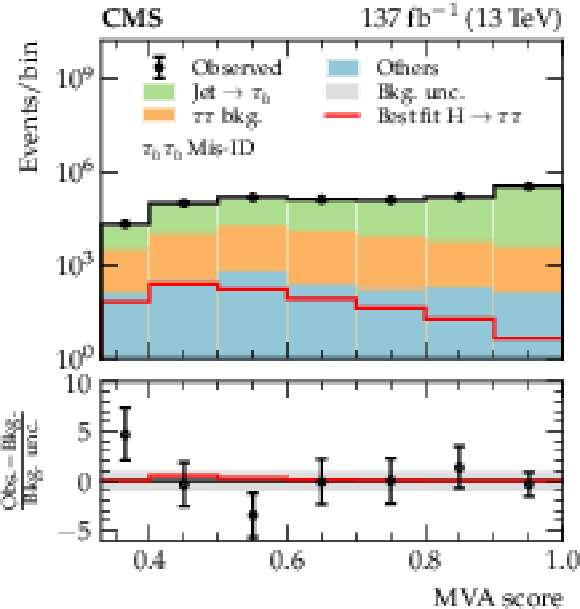
png pdf |
Figure 7-b:
The post-fit MVA score distribution for the Mis-ID category in the ${{\tau _\mathrm {h}} {\tau _\mathrm {h}}}$ channel. The distribution is inclusive in ${\tau _\mathrm {h}}$ decay mode. The best fit signal distribution is overlaid. In the lower panel, the data minus the background template divided by the uncertainty in the background template is displayed, as well as the signal distribution divided by the uncertainty in the background template. The uncertainty band accounts for all sources of systematic uncertainty in the background prediction, after the fit to data. |

png pdf |
Figure 8:
Distributions of ${\phi _{{\textit {CP}}}}$ in the ${\mu \rho}$ (upper) and ${\mu \pi}$ (lower) channels in windows of increasing MVA score, shown on top of each window. The best fit and pseudoscalar (PS) signal distributions are overlaid. The $x$-axis represents the cyclic bins in ${\phi _{{\textit {CP}}}}$ in the range of $(0, 360^{\circ})$. In the lower panels, the data minus the background template divided by the uncertainty in the background template is displayed, as well as the signal distributions divided by the uncertainty in the background template. The uncertainty band accounts for all sources of systematic uncertainty in the background prediction, after the fit to data. |

png pdf |
Figure 8-a:
Distribution of ${\phi _{{\textit {CP}}}}$ in the ${\mu \rho}$ channel in windows of increasing MVA score, shown on top of the window. The best fit and pseudoscalar (PS) signal distributions are overlaid. The $x$-axis represents the cyclic bins in ${\phi _{{\textit {CP}}}}$ in the range of $(0, 360^{\circ})$. In the lower panel, the data minus the background template divided by the uncertainty in the background template is displayed, as well as the signal distributions divided by the uncertainty in the background template. The uncertainty band accounts for all sources of systematic uncertainty in the background prediction, after the fit to data. |
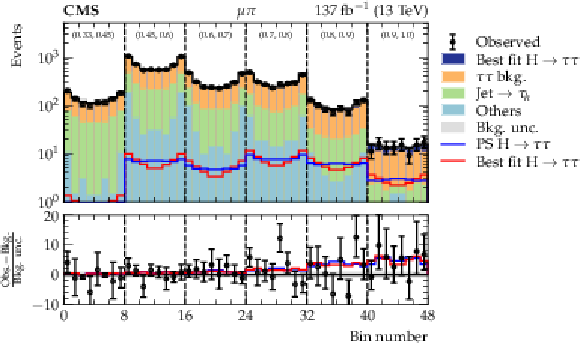
png pdf |
Figure 8-b:
Distribution of ${\phi _{{\textit {CP}}}}$ in the ${\mu \pi}$ channel in windows of increasing MVA score, shown on top of the window. The best fit and pseudoscalar (PS) signal distributions are overlaid. The $x$-axis represents the cyclic bins in ${\phi _{{\textit {CP}}}}$ in the range of $(0, 360^{\circ})$. In the lower panel, the data minus the background template divided by the uncertainty in the background template is displayed, as well as the signal distributions divided by the uncertainty in the background template. The uncertainty band accounts for all sources of systematic uncertainty in the background prediction, after the fit to data. |

png pdf |
Figure 9:
Distributions of ${\phi _{{\textit {CP}}}}$ in the ${\rho \rho}$ (upper) and ${\pi \rho}$ (lower) channels in windows of increasing MVA score, shown on top of each window. The best fit and pseudoscalar (PS) signal distributions are overlaid. The $x$-axis represents the cyclic bins in ${\phi _{{\textit {CP}}}}$ in the range of $(0, 360^{\circ})$. In the lower panels, the data minus the background template divided by the uncertainty in the background template is displayed, as well as the signal distributions divided by the uncertainty in the background template. The uncertainty band accounts for all sources of systematic uncertainty in the background prediction, after the fit to data. |

png pdf |
Figure 9-a:
Distribution of ${\phi _{{\textit {CP}}}}$ in the ${\rho \rho}$ channel in windows of increasing MVA score, shown on top of the window. The best fit and pseudoscalar (PS) signal distributions are overlaid. The $x$-axis represents the cyclic bins in ${\phi _{{\textit {CP}}}}$ in the range of $(0, 360^{\circ})$. In the lower panel, the data minus the background template divided by the uncertainty in the background template is displayed, as well as the signal distributions divided by the uncertainty in the background template. The uncertainty band accounts for all sources of systematic uncertainty in the background prediction, after the fit to data. |

png pdf |
Figure 9-b:
Distribution of ${\phi _{{\textit {CP}}}}$ in the ${\pi \rho}$ channel in windows of increasing MVA score, shown on top of the window. The best fit and pseudoscalar (PS) signal distributions are overlaid. The $x$-axis represents the cyclic bins in ${\phi _{{\textit {CP}}}}$ in the range of $(0, 360^{\circ})$. In the lower panel, the data minus the background template divided by the uncertainty in the background template is displayed, as well as the signal distributions divided by the uncertainty in the background template. The uncertainty band accounts for all sources of systematic uncertainty in the background prediction, after the fit to data. |
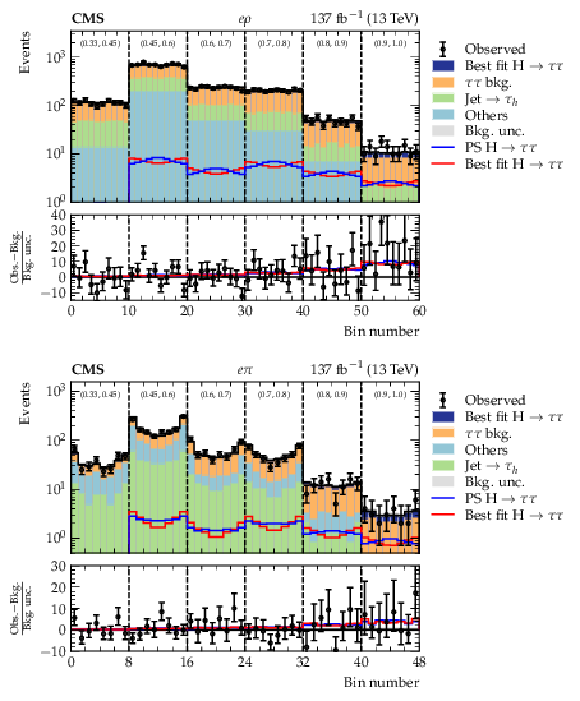
png pdf |
Figure 10:
Distributions of ${\phi _{{\textit {CP}}}}$ in the ${\mathrm{e} \rho}$ (upper) and ${\mathrm{e} \pi}$ (lower) channels in windows of increasing MVA score, shown on top of each window. The best fit and pseudoscalar (PS) signal distributions are overlaid. The $x$-axis represents the cyclic bins in ${\phi _{{\textit {CP}}}}$ in the range of $(0, 360^{\circ})$. In the lower panels, the data minus the background template divided by the uncertainty in the background template is displayed, as well as the signal distributions divided by the uncertainty in the background template. The uncertainty band accounts for all sources of systematic uncertainty in the background prediction, after the fit to data. |

png pdf |
Figure 10-a:
Distribution of ${\phi _{{\textit {CP}}}}$ in the ${\mathrm{e} \rho}$ channel in windows of increasing MVA score, shown on top of the window. The best fit and pseudoscalar (PS) signal distributions are overlaid. The $x$-axis represents the cyclic bins in ${\phi _{{\textit {CP}}}}$ in the range of $(0, 360^{\circ})$. In the lower panel, the data minus the background template divided by the uncertainty in the background template is displayed, as well as the signal distributions divided by the uncertainty in the background template. The uncertainty band accounts for all sources of systematic uncertainty in the background prediction, after the fit to data. |
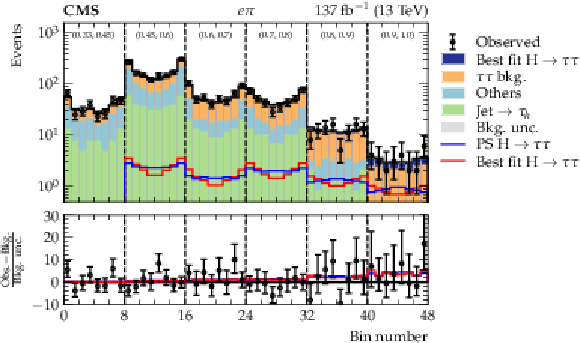
png pdf |
Figure 10-b:
Distribution of ${\phi _{{\textit {CP}}}}$ in the ${\mathrm{e} \pi}$ channel in windows of increasing MVA score, shown on top of the window. The best fit and pseudoscalar (PS) signal distributions are overlaid. The $x$-axis represents the cyclic bins in ${\phi _{{\textit {CP}}}}$ in the range of $(0, 360^{\circ})$. In the lower panel, the data minus the background template divided by the uncertainty in the background template is displayed, as well as the signal distributions divided by the uncertainty in the background template. The uncertainty band accounts for all sources of systematic uncertainty in the background prediction, after the fit to data. |
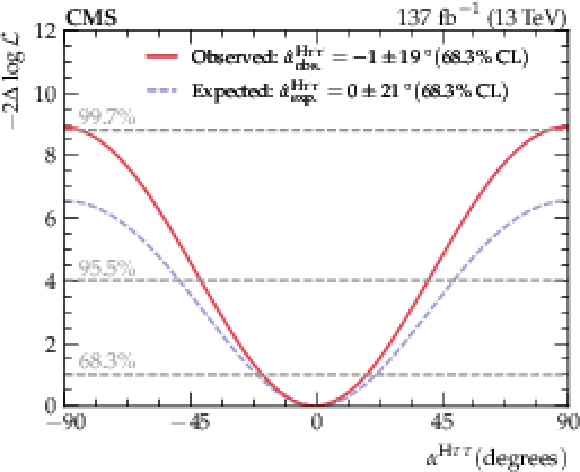
png pdf |
Figure 11:
Negative log-likelihood scan for the combination of the ${{\tau _{\mathrm{e}}} {\tau _\mathrm {h}}}$, ${\tau _{\mu} {\tau _\mathrm {h}}}$, and ${{\tau _\mathrm {h}} {\tau _\mathrm {h}}}$ channels. The observed (expected) sensitivity to distinguish between the scalar and pseudoscalar hypotheses, defined at $ {\alpha ^{\mathrm{H} \tau \tau}} = $ 0 and $ \pm 90 ^{\circ}$, respectively, is 3.0$\sigma $ (2.6$\sigma $). The observed (expected) value for ${\alpha ^{\mathrm{H} \tau \tau}}$ is $-1 \pm 19 ^{\circ}$ ($0 \pm 21 ^{\circ}$) at the 68.3% CL. At 95.5% CL the range is $ \pm 41 ^{\circ}$ ($ \pm 49 ^{\circ}$), and at the 99.7% CL the observed range is $ \pm 84 ^{\circ}$. |
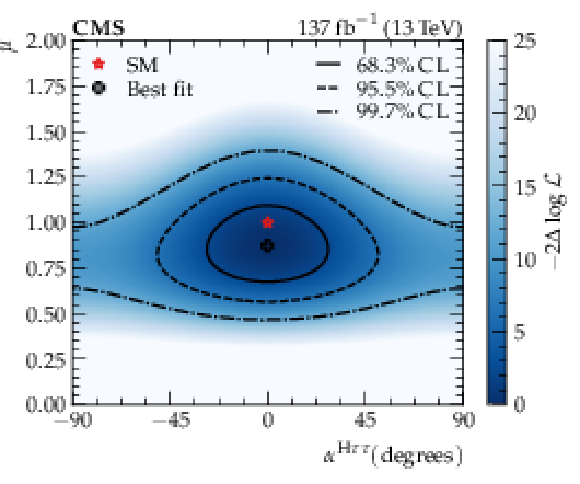
png pdf |
Figure 12:
The 2-D scan of the signal strength modifier $\mu $ versus ${\alpha ^{\mathrm{H} \tau \tau}}$. The 68.3, 95.5, and 99.7% confidence regions are overlaid. |

png pdf |
Figure 13:
The 2-D scan of the (reduced) CP-even (${\kappa _\tau}$) and CP-odd (${\tilde{\kappa}_\tau}$) $\tau$ Yukawa couplings. The 68.3, 95.5, and 99.7% confidence regions are overlaid. |
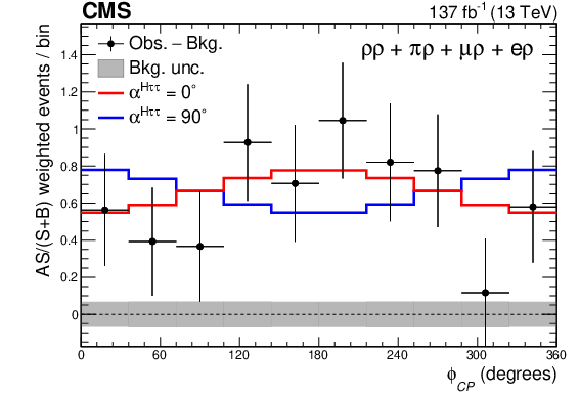
png pdf |
Figure 14:
The ${\phi _{{\textit {CP}}}}$ distributions for the ${\rho \rho}$, ${\pi \rho}$, ${\mu \rho}$, and ${\mathrm{e} \rho}$ channels weighed by A S/(S+B) are combined. Events are included from all MVA score bins in the four signal categories. The background is subtracted from the data. The scalar distribution is depicted in red, while the pseudoscalar is displayed in blue. In the predictions, the rate parameters are taken from their best fit values. The grey uncertainty band indicates the uncertainty in the subtracted background component. In combining the channels, a phase-shift of 180$^{\circ}$ was applied to the channels involving a lepton since this channel has a phase difference of 180$^{\circ}$ with respect to the two hadronic channels due to a sign-flip in the spectral function of the light lepton. |
| Tables | |

png pdf |
Table 1:
Decay modes of $\tau$ leptons used in this analysis and their branching fractions $\mathcal {B}$ [38]. Where appropriate, we indicate the known intermediate resonances. The last row gives the shorthand notation for the decays used throughout this paper. |
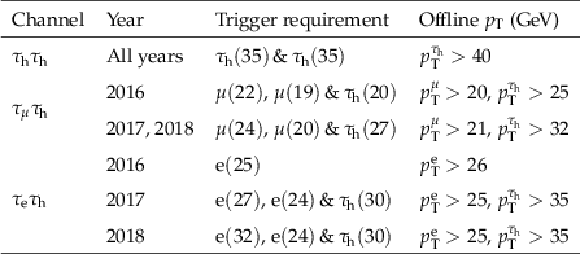
png pdf |
Table 2:
Kinematic trigger and offline requirements applied to the ${{\tau _{\mathrm{e}}} {\tau _\mathrm {h}}}$, ${\tau _{\mu} {\tau _\mathrm {h}}}$, and ${{\tau _\mathrm {h}} {\tau _\mathrm {h}}}$ channels. The trigger ${p_{\mathrm {T}}}$ requirement is indicated in parentheses (in GeV). The ${p_{\mathrm {T}}}$ thresholds indicated for the ${\tau _\mathrm {h}}$ apply only for the object matched to the hadronic trigger or to the hadronic leg from the cross trigger. |

png pdf |
Table 3:
The different sources of backgrounds in the ${{\tau _\mathrm {h}} {\tau _\mathrm {h}}}$ channel are shown in the rows and columns. The entries in the table represent the possible $\tau$ lepton pair background contribution from different processes and misidentifications and encapsulate the different experimental techniques that are deployed to estimate the background contributions. |

png pdf |
Table 4:
The different sources of backgrounds in the ${{\tau _{\ell}} {\tau _\mathrm {h}}}$ channel are shown in the rows and columns. The entries in the table represent the possible $\tau$ lepton pair background contribution from different processes and misidentifications and encapsulate the different experimental techniques that are deployed to estimate the background contributions. |
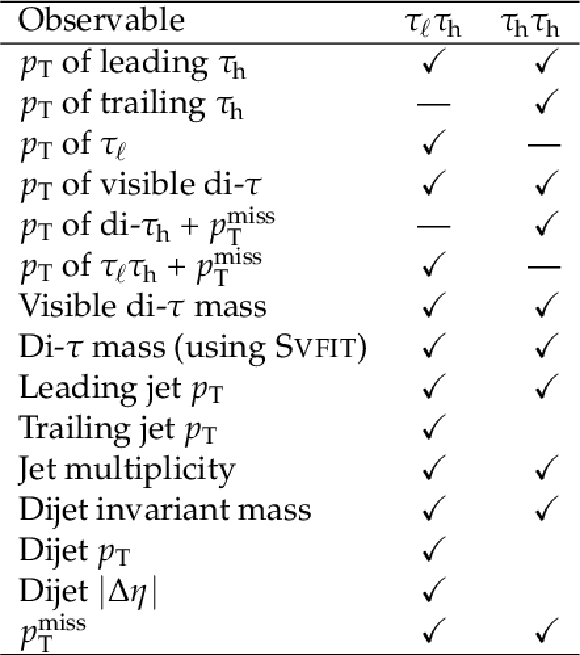
png pdf |
Table 5:
Input variables to the MVA discriminants for the ${{\tau _{\ell}} {\tau _\mathrm {h}}}$ and ${{\tau _\mathrm {h}} {\tau _\mathrm {h}}}$ channels. The {Svfit} algorithm is used to estimate the di-$\tau$ mass. |

png pdf |
Table 6:
Overview of the systematic uncertainties. The third column indicates if the source of uncertainty was treated as being correlated between the years in the fit described in Section 12. The forth column indicates if the uncertainty affects the shapes of the distributions. |
| Summary |
| The first measurement of the effective mixing angle $\alpha^{\mathrm{H \to \tau\tau}}$ between scalar and pseudoscalar $\mathrm{H\tau\tau}$ couplings has been presented for a data set of proton-proton collisions at $\sqrt{s} = $ 13 TeV corresponding to an integrated luminosity of 137 fb$^{-1}$. The data were collected with the CMS experiment at the LHC in the period 2016-2018. The following $\tau$ lepton decay modes were included: $\mathrm{e^{\pm}}$, $\mu^{\pm}$, $\pi^{\pm}$, $\rho^{\pm} \to \pi^{\pm}\pi^{0}$, $\mathrm{q}_{1}^\pm\to\pi^{\pm}\pi^{0}\pi^{0}$, and $\mathrm{q}_{1}^\pm\to\pi^{\pm}\pi^{\mp}\pi^{\pm}$. Dedicated strategies were adopted to reconstruct the angle $\phi_{\text{CP}}$ between the $\tau$ decay planes for the various $\tau$ decay modes. The data disfavour the pure CP-odd scenario at 3.0 standard deviations. The observed effective mixing angle is found to be $-1 \pm 19 ^{\circ}$, while the expected value is $0 \pm 21 ^{\circ}$ at the 68.3% confidence level (CL). The observed and expected uncertainties are found to be $ \pm 41 ^{\circ}$ and $ \pm 49 ^{\circ}$ at the 95.5% CL, respectively, and the observed sensitivity at the 99.7% CL is $ \pm 84 ^{\circ}$. The leading uncertainty in the measurement is statistical, implying that the precision of the measurement will increase with the accumulation of more collision data. The measurement is consistent with the standard model expectation, and reduces the allowed parameter space for its extensions. Tabulated results are provided in HEPDATA [110]. |
| Additional Figures | |
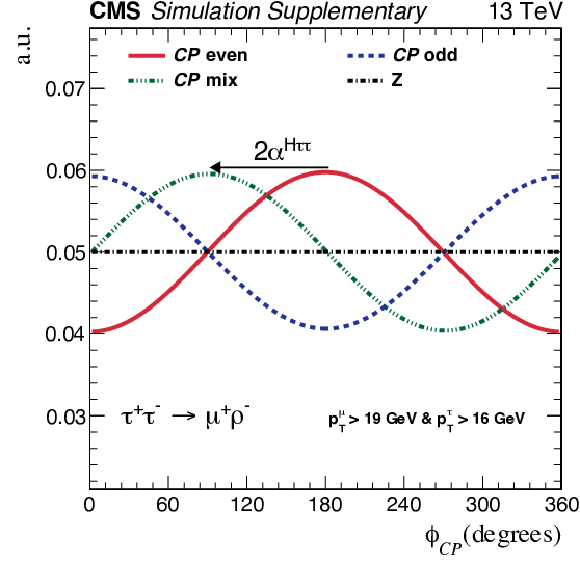
png pdf |
Additional Figure 1:
The normalised distribution of $\phi _{\textit {CP}}$ between the ${\tau}$ decay planes in the visible rest frame in the $ {{\mu}} {\pi}$ channel. The distributions are for a decaying scalar (CP-even, solid red), pseudoscalar (CP-odd, dash blue), a maximal mixing angle of 45$^{\circ}$ (CP-mix, dash-dot-dot green), and a Z vector boson (black dash-dot). A ${p_{\mathrm {T}}}$ cutoff of 19 (16) GeV is applied on the visible leptonic (hadronic) tau decay products. |

png pdf |
Additional Figure 2:
The normalised distribution of $\phi _{\textit {CP}}$ between the ${\tau}$ decay planes in the visible rest frame in the $ {\pi} {\rho} $ channel. The distributions are for a decaying scalar (CP-even, solid red), pseudoscalar (CP-odd, dash blue), a maximal mixing angle of 45$^{\circ}$ (CP-mix, dash-dot-dot green), and a Z vector boson (black dash-dot). A ${p_{\mathrm {T}}}$ cutoff of 33 GeV is applied on the visible tau decay products. |
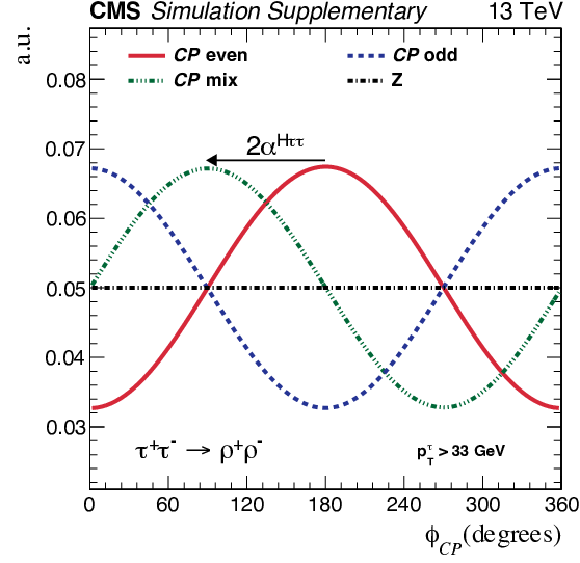
png pdf |
Additional Figure 3:
The normalised distribution of $\phi _{\textit {CP}}$ between the ${\tau}$ decay planes in visible rest frame in the $ {\rho} {\rho} $ channel. The distributions are for a decaying scalar (CP-even, solid red), pseudoscalar (CP-odd, dash blue), a maximal mixing angle of 45$^{\circ}$ (CP-mix, dash-dot-dot green), and a Z vector boson (black dash-dot). A ${p_{\mathrm {T}}}$ cutoff of 33 GeV is applied on the visible tau decay products. |
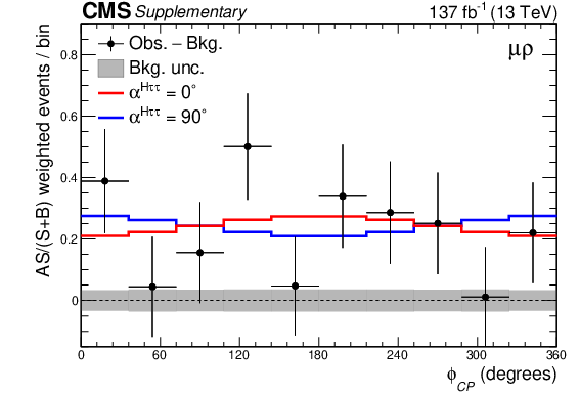
png pdf |
Additional Figure 4:
The $\phi _{\textit {CP}}$ distribution in the $ {{\mu}} {\rho} $ channel. Events were collected from all years and MVA score bins. The background is subtracted from the data. The events are reweighed via AS/(S+B), in which S and B are the signal and background rates, respectively, and A is a measure for the average asymmetry between the scalar and pseudoscalar distributions. The definition of the value of A per bin is $ {| \textit {CP}^{\text {even}}-\textit {CP}^{\text {odd}} |}/(\textit {CP}^{\text {even}}+\textit {CP}^{\text {odd}})$, and A is normalised to the total number of bins. In this equation $\textit {CP}^{\text {even}}$ and $\textit {CP}^{\text {odd}}$ are the scalar and pseudoscalar contributions per bin. The scalar distribution is depicted in red, while the pseudoscalar is displayed in blue. In the predictions the rate parameters are taken from their best fit values. The grey uncertainty band indicates the uncertainty in the subtracted background component. It should be noted that an overall phase-shift of 180$^{\circ}$ was applied to the channel. |

png pdf |
Additional Figure 5:
The $\phi _{\textit {CP}}$ distribution in the $ {\pi} {\rho} $ channel. Events were collected from all years and MVA score bins. The background is subtracted from the data. The events are reweighed via AS/(S+B), in which S and B are the signal and background rates, respectively, and A is a measure for the average asymmetry between the scalar and pseudoscalar distributions. The definition of the value of A per bin is $ {| \textit {CP}^{\text {even}}-\textit {CP}^{\text {odd}} |}/(\textit {CP}^{\text {even}}+\textit {CP}^{\text {odd}})$, and A is normalised to the total number of bins. In this equation $\textit {CP}^{\text {even}}$ and $\textit {CP}^{\text {odd}}$ are the scalar and pseudoscalar contributions per bin. The scalar distribution is depicted in red, while the pseudoscalar is displayed in blue. In the predictions the rate parameters are taken from their best fit values. The grey uncertainty band indicates the uncertainty in the subtracted background component. |
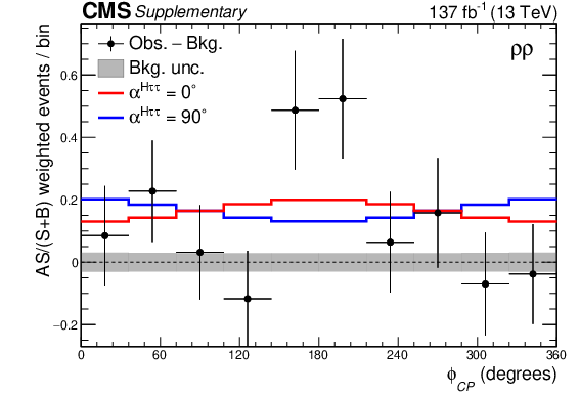
png pdf |
Additional Figure 6:
The $\phi _{\textit {CP}}$ distribution in the $ {\rho} {\rho} $ channel. Events were collected from all years and MVA score bins. The background is subtracted from the data. The events are reweighed via AS/(S+B), in which S and B are the signal and background rates, respectively, and A is a measure for the average asymmetry between the scalar and pseudoscalar distributions. The definition of the value of A per bin is $ {| \textit {CP}^{\text {even}}-\textit {CP}^{\text {odd}} |}/(\textit {CP}^{\text {even}}+\textit {CP}^{\text {odd}})$, and A is normalised to the total number of bins. In this equation $\textit {CP}^{\text {even}}$ and $\textit {CP}^{\text {odd}}$ are the scalar and pseudoscalar contributions per bin. The scalar distribution is depicted in red, while the pseudoscalar is displayed in blue. In the predictions the rate parameters are taken from their best fit values. The grey uncertainty band indicates the uncertainty in the subtracted background component. |

png pdf |
Additional Figure 7:
The $\phi _{\textit {CP}}$ distribution in the $ {\mathrm {e}} {\rho} $ channel. Events were collected from all years and MVA score bins. The background is subtracted from the data. The events are reweighed via AS/(S+B), in which S and B are the signal and background rates, respectively, and A is a measure for the average asymmetry between the scalar and pseudoscalar distributions. The definition of the value of A per bin is $ {| \textit {CP}^{\text {even}}-\textit {CP}^{\text {odd}} |}/(\textit {CP}^{\text {even}}+\textit {CP}^{\text {odd}})$, and A is normalised to the total number of bins. In this equation $\textit {CP}^{\text {even}}$ and $\textit {CP}^{\text {odd}}$ are the scalar and pseudoscalar contributions per bin. The scalar distribution is depicted in red, while the pseudoscalar is displayed in blue. In the predictions the rate parameters are taken from their best fit values. The grey uncertainty band indicates the uncertainty in the subtracted background component. It should be noted that an overall phase-shift of 180$^{\circ}$ was applied to the channel. |
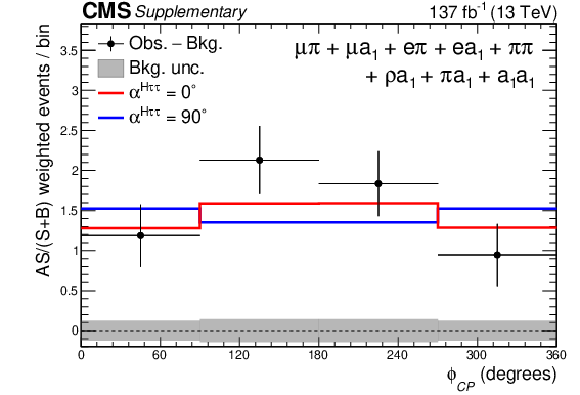
png pdf |
Additional Figure 8:
The $\phi _{\textit {CP}}$ distribution for combination of the 13 least sensitive $\tau _{l}\tau _{\mathrm {h}}$ and $\tau _{\mathrm {h}}\tau _{\mathrm {h}}$ channels added together. Events were collected from all years and MVA score bins. The background is subtracted from the data. The events are reweighed via AS/(S+B), in which S and B are the signal and background rates, respectively, and A is a measure for the average asymmetry between the scalar and pseudoscalar distributions. The definition of the value of A per bin is $ {| \textit {CP}^{\text {even}}-\textit {CP}^{\text {odd}} |}/(\textit {CP}^{\text {even}}+\textit {CP}^{\text {odd}})$, and A is normalised to the total number of bins. In this equation $\textit {CP}^{\text {even}}$ and $\textit {CP}^{\text {odd}}$ are the scalar and pseudoscalar contributions per bin. The scalar distribution is depicted in red, while the pseudoscalar is displayed in blue. In the predictions the rate parameters are taken from their best fit values. The grey uncertainty band indicates the uncertainty in the subtracted background component. In combining the channels, a phase-shift of 180$^{\circ}$ was applied to a subset of the channels such that the distributions are all in phase. |

png pdf |
Additional Figure 9:
Distributions of $\phi _{\textit {CP}}$ in the $ {{\mu}}\mathrm {a_{1}^{3pr}}$ channel for an event sample dominated by Drell-Yan events. Events were selected for which $\alpha ^{\rho}_{-}\geq \pi /4$ for the intermediate ${\rho}$. The Drell-Yan background template is extracted from simulation, while the $\text {jet}\to \tau _{\mathrm {h}}$ background is obtained from the $F_{\text {F}}$ method. The remaining backgrounds are summarised in the template named Other. In the lower plot the ratio between data and the prediction is displayed together with the systematic uncertainty band. |

png pdf |
Additional Figure 10:
Distributions of $\phi _{\textit {CP}}$ in the $ {{\mu}}\mathrm {a_{1}^{1pr}}$ channel for an event sample dominated by Drell-Yan events. Events were selected for which $\alpha ^{\rho}_{-}$, calculated for the intermediate $\mathrm {a_{1}^{1pr}}$, was $\geq \pi /4$. The Drell-Yan background template is extracted from simulation, while the $\text {jet}\to \tau _{\mathrm {h}}$ background is obtained from the $F_{\text {F}}$ method. The remaining backgrounds are summarised in the template named Other. In the lower plot the ratio between data and the prediction is displayed together with the systematic uncertainty band. |
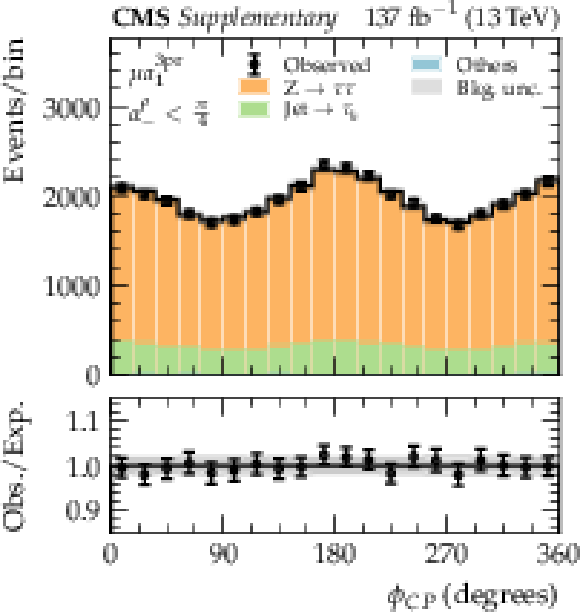
png pdf |
Additional Figure 11:
Distributions of $\phi _{\textit {CP}}$ in the $ {{\mu}}\mathrm {a_{1}^{3pr}}$ channel for an event sample dominated by Drell-Yan events. Events were selected for which $\alpha ^{\rho}_{-} < \pi /4$ for the intermediate ${\rho}$. The Drell-Yan background template is extracted from simulation, while the $\text {jet}\to \tau _{\mathrm {h}}$ background is obtained from the $F_{\text {F}}$ method. The remaining backgrounds are summarised in the template named Other. In the lower plot the ratio between data and the prediction is displayed together with the systematic uncertainty band. |

png pdf |
Additional Figure 12:
Distributions of $\phi _{\textit {CP}}$ in the $ {{\mu}}\mathrm {a_{1}^{1pr}}$ channel for an event sample dominated by Drell-Yan events. Events were selected for which $\alpha ^{\rho}_{-}$, calculated for the intermediate $\mathrm {a_{1}^{1pr}}$, was $ < \pi /4$. The Drell-Yan background template is extracted from simulation, while the $\text {jet}\to \tau _{\mathrm {h}}$ background is obtained from the $F_{\text {F}}$ method. The remaining backgrounds are summarised in the template named Other. In the lower plot the ratio between data and the prediction is displayed together with the systematic uncertainty band. |
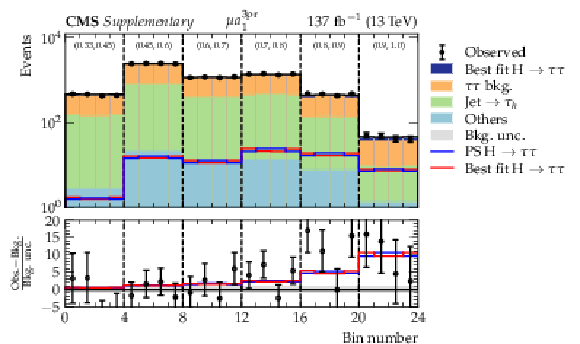
png pdf |
Additional Figure 13:
Distributions of $\phi _{\textit {CP}}$ in the $ {{\mu}}\mathrm {a_{1}^{3pr}}$ channel in windows of increasing MVA score, shown on top of each window. The best fit and pseudoscalar signal distributions are overlaid. The $x$ axis represents the cyclic bins in $\phi _{\textit {CP}}$ in the range of (0, 360$^{\circ}$). In the bottom plot the data minus the background template divided by the uncertainty in the background template is displayed, as well as the signal distributions divided by the uncertainty in the background template. The uncertainty band consists of the sum of the post-fit uncertainties in the background templates. |

png pdf |
Additional Figure 14:
Distributions of $\phi _{\textit {CP}}$ in the $ {{\mu}}\mathrm {a_{1}^{1pr}}$ channel in windows of increasing MVA score, shown on top of each window. The best fit and pseudoscalar signal distributions are overlaid. The $x$ axis represents the cyclic bins in $\phi _{\textit {CP}}$ in the range of (0, 360$^{\circ}$). In the bottom plot the data minus the background template divided by the uncertainty in the background template is displayed, as well as the signal distributions divided by the uncertainty in the background template. The uncertainty band consists of the sum of the post-fit uncertainties in the background templates. |
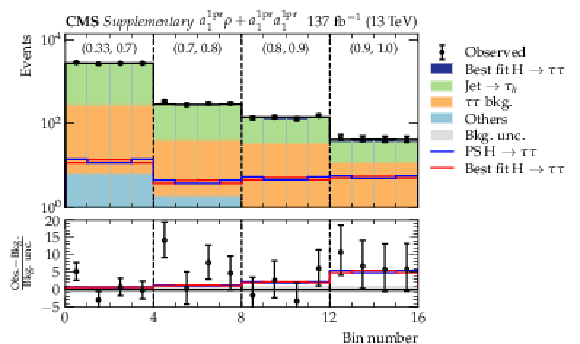
png pdf |
Additional Figure 15:
Distributions of $\phi _{\textit {CP}}$ in the $\mathrm {a_{1}^{1pr}} {\rho} +\mathrm {a_{1}^{1pr}}\mathrm {a_{1}^{1pr}}$ channels in windows of increasing MVA score, shown on top of each window. The best fit and pseudoscalar signal distributions are overlaid. The $x$ axis represents the cyclic bins in $\phi _{\textit {CP}}$ in the range of (0, 360$^{\circ}$). In the bottom plot the data minus the background template divided by the uncertainty in the background template is displayed, as well as the signal distributions divided by the uncertainty in the background template. The uncertainty band consists of the sum of the post-fit uncertainties in the background templates. |

png pdf |
Additional Figure 16:
Distributions of $\phi _{\textit {CP}}$ in the $\mathrm {a_{1}^{3pr}}\mathrm {a_{1}^{1pr}}$ channel in windows of increasing MVA score, shown on top of each window. The best fit and pseudoscalar signal distributions are overlaid. The $x$ axis represents the cyclic bins in $\phi _{\textit {CP}}$ in the range of (0, 360$^{\circ}$). In the bottom plot the data minus the background template divided by the uncertainty in the background template is displayed, as well as the signal distributions divided by the uncertainty in the background template. The uncertainty band consists of the sum of the post-fit uncertainties in the background templates. |
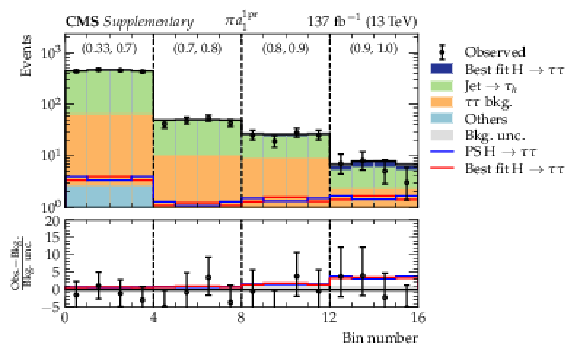
png pdf |
Additional Figure 17:
Distributions of $\phi _{\textit {CP}}$ in the $ {\pi}\mathrm {a_{1}^{1pr}}$ channel in windows of increasing MVA score, shown on top of each window. The best fit and pseudoscalar signal distributions are overlaid. The $x$ axis represents the cyclic bins in $\phi _{\textit {CP}}$ in the range of (0, 360$^{\circ}$). In the bottom plot the data minus the background template divided by the uncertainty in the background template is displayed, as well as the signal distributions divided by the uncertainty in the background template. The uncertainty band consists of the sum of the post-fit uncertainties in the background templates. |
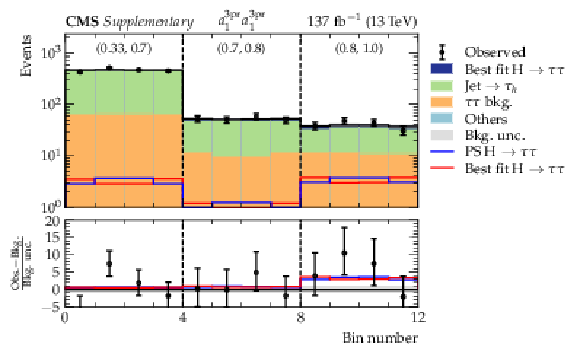
png pdf |
Additional Figure 18:
Distributions of $\phi _{\textit {CP}}$ in the $\mathrm {a_{1}^{3pr}}\mathrm {a_{1}^{3pr}}$ channel in windows of increasing MVA score, shown on top of each window. The polarimetric vector method was deployed to reconstruct $\phi _{\textit {CP}}$. The best fit and pseudoscalar signal distributions are overlaid. The $x$ axis represents the cyclic bins in $\phi _{\textit {CP}}$ in the range of (0, 360$^{\circ}$). In the bottom plot the data minus the background template divided by the uncertainty in the background template is displayed, as well as the signal distributions divided by the uncertainty in the background template. The uncertainty band consists of the sum of the post-fit uncertainties in the background templates. |

png pdf |
Additional Figure 19:
Distributions of $\phi _{\textit {CP}}$ in the $ {\pi}\mathrm {a_{1}^{3pr}}$ channel in windows of increasing MVA score, shown on top of each window. The best fit and pseudoscalar signal distributions are overlaid. The $x$ axis represents the cyclic bins in $\phi _{\textit {CP}}$ in the range of (0, 360$^{\circ}$). In the bottom plot the data minus the background template divided by the uncertainty in the background template is displayed, as well as the signal distributions divided by the uncertainty in the background template. The uncertainty band consists of the sum of the post-fit uncertainties in the background templates. |
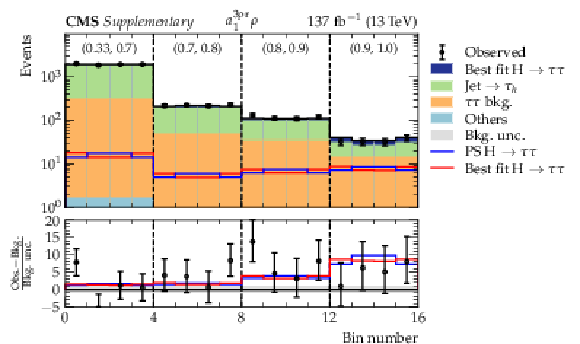
png pdf |
Additional Figure 20:
Distributions of $\phi _{\textit {CP}}$ in the $\mathrm {a_{1}^{3pr}} {\rho} $ channel in windows of increasing MVA score, shown on top of each window. The best fit and pseudoscalar signal distributions are overlaid. The $x$ axis represents the cyclic bins in $\phi _{\textit {CP}}$ in the range of (0, 360$^{\circ}$). In the bottom plot the data minus the background template divided by the uncertainty in the background template is displayed, as well as the signal distributions divided by the uncertainty in the background template. The uncertainty band consists of the sum of the post-fit uncertainties in the background templates. |

png pdf |
Additional Figure 21:
Distributions of $\phi _{\textit {CP}}$ in the $ {\pi} {\pi}$ channel in windows of increasing MVA score, shown on top of each window. The best fit and pseudoscalar signal distributions are overlaid. The $x$ axis represents the cyclic bins in $\phi _{\textit {CP}}$ in the range of (0, 360$^{\circ}$). In the bottom plot the data minus the background template divided by the uncertainty in the background template is displayed, as well as the signal distributions divided by the uncertainty in the background template. The uncertainty band consists of the sum of the post-fit uncertainties in the background templates. |
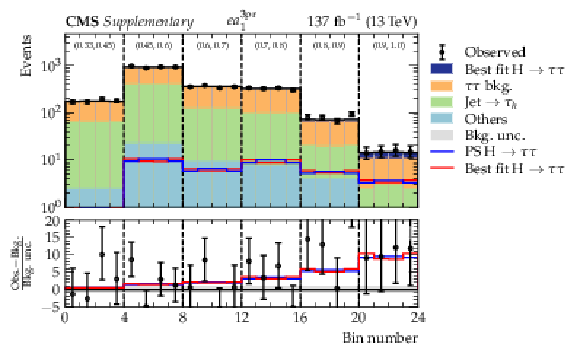
png pdf |
Additional Figure 22:
Distributions of $\phi _{\textit {CP}}$ in the $ {\mathrm {e}}\mathrm {a_{1}^{3pr}}$ channel in windows of increasing MVA score, shown on top of each window. The best fit and pseudoscalar signal distributions are overlaid. The $x$ axis represents the cyclic bins in $\phi _{\textit {CP}}$ in the range of (0, 360$^{\circ}$). In the bottom plot the data minus the background template divided by the uncertainty in the background template is displayed, as well as the signal distributions divided by the uncertainty in the background template. The uncertainty band consists of the sum of the post-fit uncertainties in the background templates. |

png pdf |
Additional Figure 23:
Distributions of $\phi _{\textit {CP}}$ in the $ {\mathrm {e}}\mathrm {a_{1}^{1pr}}$ channel in windows of increasing MVA score, shown on top of each window. The best fit and pseudoscalar signal distributions are overlaid. The $x$ axis represents the cyclic bins in $\phi _{\textit {CP}}$ in the range of (0, 360$^{\circ}$). In the bottom plot the data minus the background template divided by the uncertainty in the background template is displayed, as well as the signal distributions divided by the uncertainty in the background template. The uncertainty band consists of the sum of the post-fit uncertainties in the background templates. |

png pdf |
Additional Figure 24:
A candidate event featuring a Higgs decaying into two ${\tau}$ leptons is depicted. The ${\tau}$ leptons decay into a muon (in red) and a $\mathrm {a_{1}}$ that decays in three charged pions (indicated by the orange cone and the calorimeter cells). |
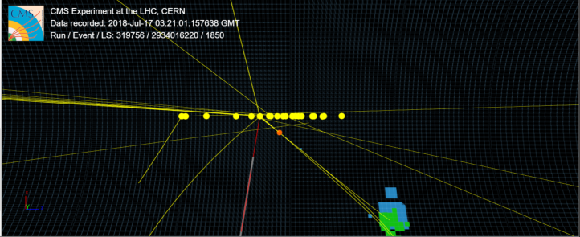
png pdf |
Additional Figure 25:
A zoomed view of a candidate event featuring a Higgs decaying into two ${\tau}$ leptons. The ${\tau}$ leptons decay into a muon (in red) and a $\mathrm {a_{1}}$ that decays into three charged pions. The displaced secondary vertex from which the tracks of the three charged pions candidates are emerging is indicated by the red circle. The pileup vertices are also indicated. |
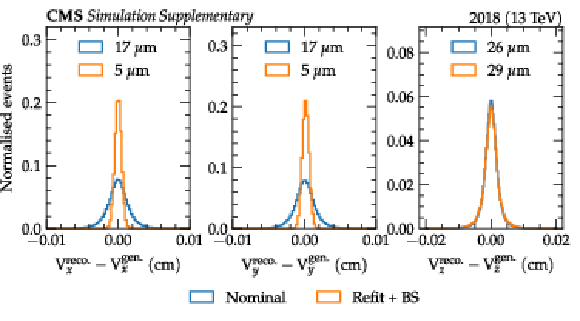
png pdf |
Additional Figure 26:
The resolution of the x (left), y (middle) and z (right) coordinate of the nominal primary vertex (blue), and the refitted beamspot-corrected primary vertex (red). The width of the distributions is indicated in the legend. Event samples were utilised in which a Higgs boson was produced in the gluon fusion and vector boson fusion process, and the samples were reweighed to their standard model cross section. |
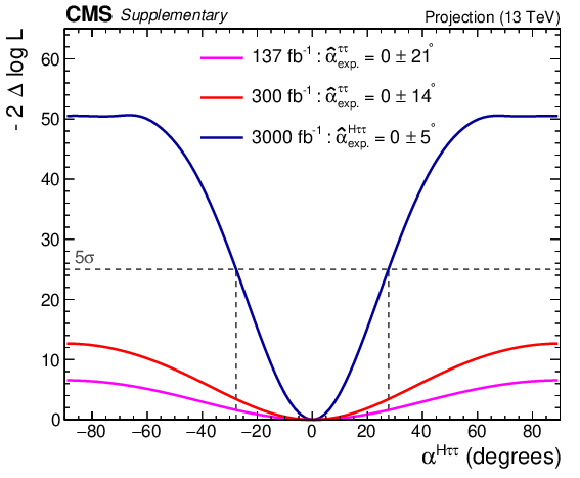
png pdf |
Additional Figure 27:
Expected negative log-likelihood scan for the combination of the $\tau _{{\mathrm {e}}}\tau _{\mathrm {h}}$, $\tau _{{{\mu}}}\tau _{\mathrm {h}}$ and $\tau _{\mathrm {h}}\tau _{\mathrm {h}}$ channels, including predictions for LHC Run 3 and Phase 2 integrated luminosities. The extrapolations have been made assuming systematic uncertainties as derived for the main analysis, while the statistical uncertainties were adjusted to different luminosity scenarios. The expected sensitivity to distinguish between the scalar and pseudo-scalar hypotheses, defined at $\alpha ^{{\mathrm {H}} \tau \tau} = $ 0 and $ \pm $ 90$ ^{\circ}$, respectively, exceeds 5 standard deviations for the Phase 2 scenario. |
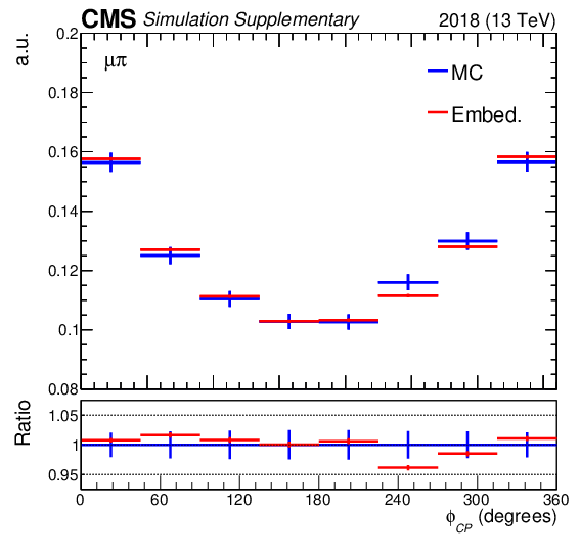
png pdf |
Additional Figure 28:
The ratio of $\phi _{\textit {CP}}$ for simulated events and events from the embedded samples in the $ {{\mu}} {\pi}$ final state are displayed. The shapes are consistent within statistical fluctuations. |

png pdf |
Additional Figure 29:
The ratio of $\phi _{\textit {CP}}$ for simulated events and events from the embedded samples in the $ {{\mu}} {\rho} $ final state are displayed. A minor residual effect is present in the embedded sample that is a consequence of misalignment effects in the embedding procedure. These effects cancel in the bin flattening procedure that is applied. |

png pdf |
Additional Figure 30:
Observed correlations between $\alpha ^{{\mathrm {H}} \tau \tau}$ and the signal strength modifiers. |

png pdf |
Additional Figure 31:
Two-dimensional scan of the $ {\mathrm {g}} {\mathrm {g}} {\mathrm {H}} $ signal strength modifier versus $\alpha ^{{\mathrm {H}} \tau \tau}$. The VBF+$ {\mathrm {H}} $ signal strength modifier is profiled. |

png pdf |
Additional Figure 32:
Two-dimensional scan of the VBF+$ {\mathrm {H}} $ signal strength modifier versus $\alpha ^{{\mathrm {H}} \tau \tau}$. The $ {\mathrm {g}} {\mathrm {g}} {\mathrm {H}} $ signal strength modifier is profiled. |
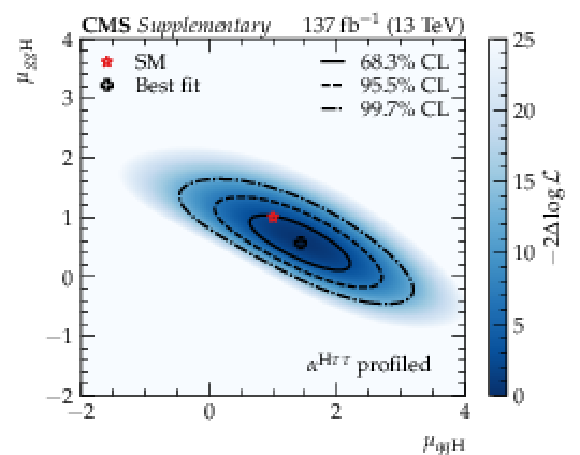
png pdf |
Additional Figure 33:
Two-dimensional scan of the $ {\mathrm {g}} {\mathrm {g}} {\mathrm {H}} $ and VBF+$ {\mathrm {H}} $ signal strength modifiers. The value of $\alpha ^{{\mathrm {H}} \tau \tau}$ is profiled. |
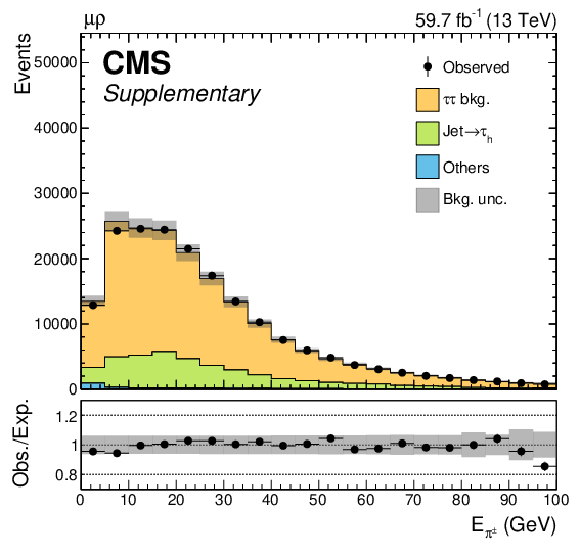
png pdf |
Additional Figure 34:
Observed and expected distribution of the ${\pi ^{\pm}}$ energy from the $ {\tau}\rightarrow {\rho} \nu \rightarrow {\pi ^{\pm}} {\pi ^0}\nu $ decay chain in the $\tau _{{{\mu}}}\tau _{\mathrm {h}}$ channel, produced using the 2018 dataset prior to the fit used for the signal extraction. The invariant mass of the visible $ {\tau} {\tau}$ decay products is required to be smaller than 90 GeV in order to select a large fraction of $ {\mathrm {Z}} \rightarrow \tau \tau $ events. The uncertainty band includes statistical uncertainties and systematic uncertainties that affect the normalisation of the background distribution. |
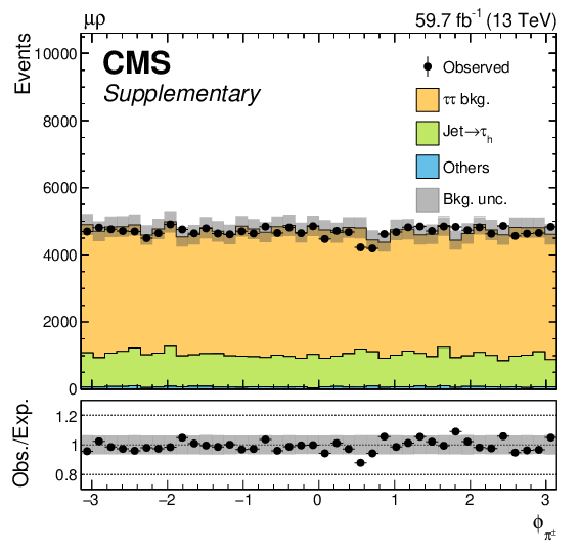
png pdf |
Additional Figure 35:
Observed and expected distribution of the ${\pi ^{\pm}}$ azimuthal angle $\phi $ from the $ {\tau}\rightarrow {\rho} \nu \rightarrow {\pi ^{\pm}} {\pi ^0}\nu $ decay chain in the $\tau _{{{\mu}}}\tau _{\mathrm {h}}$ channel, produced using the 2018 dataset prior to the fit used for the signal extraction. The invariant mass of the visible $ {\tau} {\tau}$ decay products is required to be smaller than 90 GeV in order to select a large fraction of $ {\mathrm {Z}} \rightarrow \tau \tau $ events. The uncertainty band includes statistical uncertainties and systematic uncertainties that affect the normalisation of the background distribution. |

png pdf |
Additional Figure 36:
Observed and expected distribution of the ${\pi ^{\pm}}$ pseudorapidity $\eta $ from the $ {\tau}\rightarrow {\rho} \nu \rightarrow {\pi ^{\pm}} {\pi ^0}\nu $ decay chain in the $\tau _{{{\mu}}}\tau _{\mathrm {h}}$ channel, produced using the 2018 dataset prior to the fit used for the signal extraction. The invariant mass of the visible $ {\tau} {\tau}$ decay products is required to be smaller than 90 GeV in order to select a large fraction of $ {\mathrm {Z}} \rightarrow \tau \tau $ events. The uncertainty band includes statistical uncertainties and systematic uncertainties that affect the normalisation of the background distribution. |
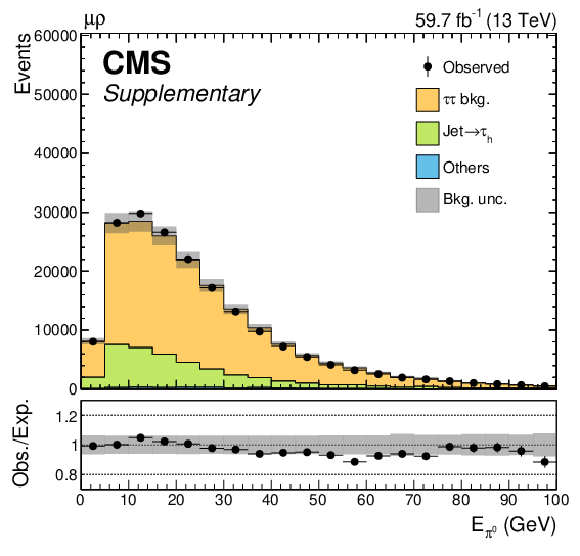
png pdf |
Additional Figure 37:
Observed and expected distribution of the ${\pi ^0}$ energy from the $ {\tau}\rightarrow {\rho} \nu \rightarrow {\pi ^{\pm}} {\pi ^0}\nu $ decay chain in the $\tau _{{{\mu}}}\tau _{\mathrm {h}}$ channel, produced using the 2018 dataset prior to the fit used for the signal extraction. The invariant mass of the visible $ {\tau} {\tau}$ decay products is required to be smaller than 90 GeV in order to select a large fraction of $ {\mathrm {Z}} \rightarrow \tau \tau $ events. The uncertainty band includes statistical uncertainties and systematic uncertainties that affect the normalisation of the background distribution. |
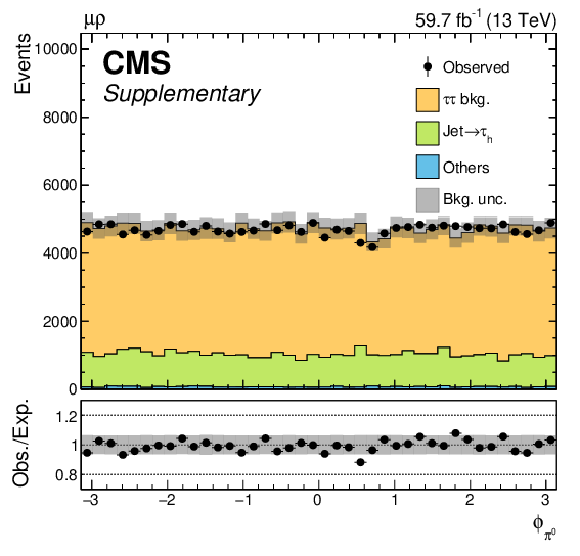
png pdf |
Additional Figure 38:
Observed and expected distribution of the ${\pi ^0}$ azimuthal angle $\phi $ from the $ {\tau}\rightarrow {\rho} \nu \rightarrow {\pi ^{\pm}} {\pi ^0}\nu $ decay chain in the $\tau _{{{\mu}}}\tau _{\mathrm {h}}$ channel, produced using the 2018 dataset prior to the fit used for the signal extraction. The invariant mass of the visible $ {\tau} {\tau}$ decay products is required to be smaller than 90 GeV in order to select a large fraction of $ {\mathrm {Z}} \rightarrow \tau \tau $ events. The uncertainty band includes statistical uncertainties and systematic uncertainties that affect the normalisation of the background distribution. |
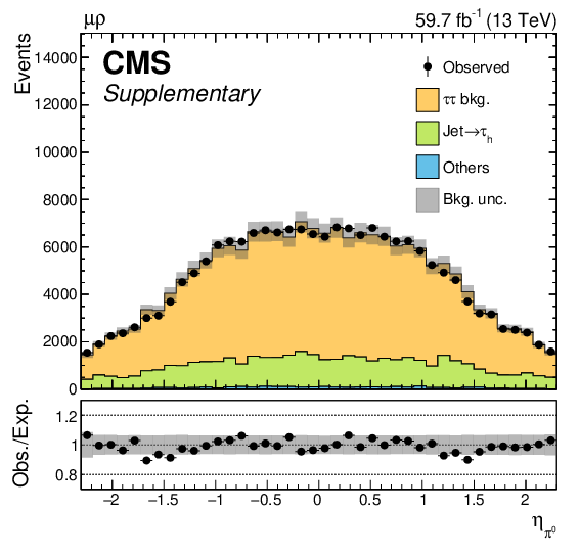
png pdf |
Additional Figure 39:
Observed and expected distribution of the ${\pi ^0}$ pseudorapidity $\eta $ from the $ {\tau}\rightarrow {\rho} \nu \rightarrow {\pi ^{\pm}} {\pi ^0}\nu $ decay chain in the $\tau _{{{\mu}}}\tau _{\mathrm {h}}$ channel, produced using the 2018 dataset prior to the fit used for the signal extraction. The invariant mass of the visible $ {\tau} {\tau}$ decay products is required to be smaller than 90 GeV in order to select a large fraction of $ {\mathrm {Z}} \rightarrow \tau \tau $ events. The uncertainty band includes statistical uncertainties and systematic uncertainties that affect the normalisation of the background distribution. |
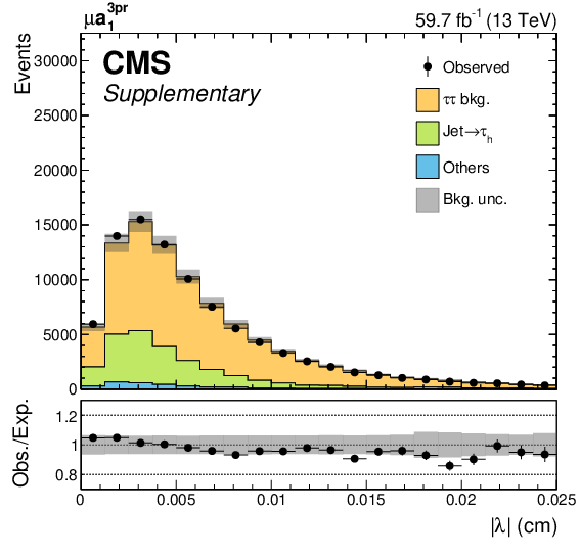
png pdf |
Additional Figure 40:
Observed and expected distribution of the ${\pi ^{\pm}}$ impact parameter ($\lambda $) magnitude from $ {\tau}\rightarrow {\pi ^{\pm}} \nu $ decays in the $\tau _{{{\mu}}}\tau _{\mathrm {h}}$ channel, produced using the 2018 dataset prior to the fit used for the signal extraction. The invariant mass of the visible $ {\tau} {\tau}$ decay products is required to be smaller than 90 GeV in order to select a large fraction of $ {\mathrm {Z}} \rightarrow \tau \tau $ events. The uncertainty band includes statistical uncertainties and systematic uncertainties that affect the normalisation of the background distribution. |

png pdf |
Additional Figure 41:
Observed and expected distribution of the ${\pi ^{\pm}}$ impact parameter ($\lambda $) azimuthal angle $\phi $ from $ {\tau}\rightarrow {\pi ^{\pm}} \nu $ decays in the $\tau _{{{\mu}}}\tau _{\mathrm {h}}$ channel, produced using the 2018 dataset prior to the fit used for the signal extraction. The invariant mass of the visible $ {\tau} {\tau}$ decay products is required to be smaller than 90 GeV in order to select a large fraction of $ {\mathrm {Z}} \rightarrow \tau \tau $ events. The uncertainty band includes statistical uncertainties and systematic uncertainties that affect the normalisation of the background distribution. |
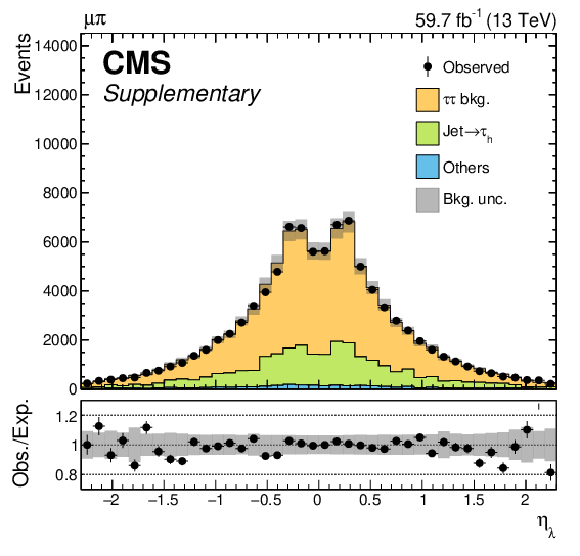
png pdf |
Additional Figure 42:
Observed and expected distribution of the ${\pi ^{\pm}}$ impact parameter ($\lambda $) pseudorapidity $\eta $ from $ {\tau}\rightarrow {\pi ^{\pm}} \nu $ decays in the $\tau _{{{\mu}}}\tau _{\mathrm {h}}$ channel, produced using the 2018 dataset prior to the fit used for the signal extraction. The invariant mass of the visible $ {\tau} {\tau}$ decay products is required to be smaller than 90 GeV in order to select a large fraction of $ {\mathrm {Z}} \rightarrow \tau \tau $ events. The uncertainty band includes statistical uncertainties and systematic uncertainties that affect the normalisation of the background distribution. |

png pdf |
Additional Figure 43:
Observed and expected distribution of the ${\tau}$ secondary vertex (SV) length relative to the primary vertex (PV) position from the $ {\tau}\rightarrow \mathrm {a_{1}}\nu \rightarrow {\pi ^{\pm}} {\pi^{\mp}} {\pi ^{\pm}} \nu $ decay chain in the $\tau _{{{\mu}}}\tau _{\mathrm {h}}$ channel, produced using the 2018 dataset prior to the fit used for the signal extraction. The invariant mass of the visible $ {\tau} {\tau}$ decay products is required to be smaller than 90 GeV in order to select a large fraction of $ {\mathrm {Z}} \rightarrow \tau \tau $ events. The uncertainty band includes statistical uncertainties and systematic uncertainties that affect the normalisation of the background distribution. |
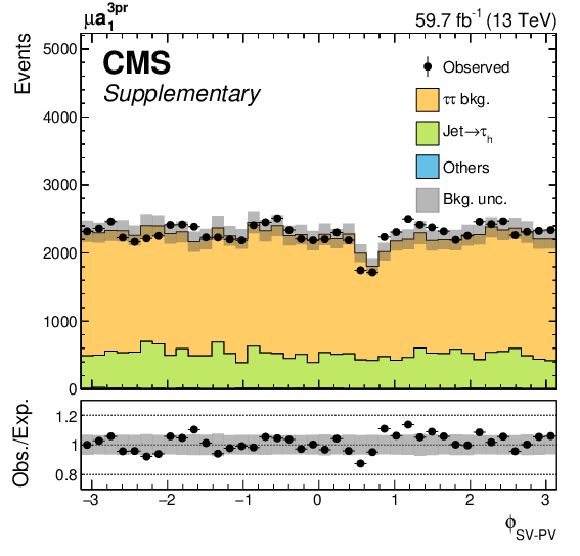
png pdf |
Additional Figure 44:
Observed and expected distribution of the ${\tau}$ secondary vertex (SV) azimuthal angle $\phi $ relative to the primary vertex (PV) position from the $ {\tau}\rightarrow \mathrm {a_{1}}\nu \rightarrow {\pi ^{\pm}} {\pi^{\mp}} {\pi ^{\pm}} \nu $ decay chain in the $\tau _{{{\mu}}}\tau _{\mathrm {h}}$ channel, produced using the 2018 dataset prior to the fit used for the signal extraction. The invariant mass of the visible $ {\tau} {\tau}$ decay products is required to be smaller than 90 GeV in order to select a large fraction of $ {\mathrm {Z}} \rightarrow \tau \tau $ events. The uncertainty band includes statistical uncertainties and systematic uncertainties that affect the normalisation of the background distribution. |
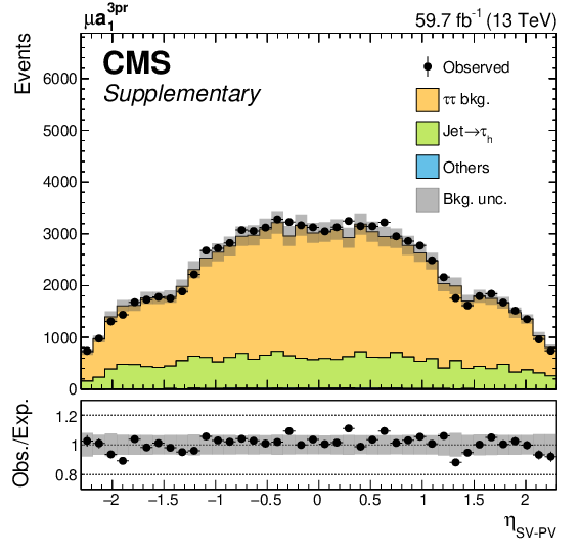
png pdf |
Additional Figure 45:
Observed and expected distribution of the ${\tau}$ secondary vertex (SV) pseudorapidity $\eta $ relative to the primary vertex (PV) position from the $ {\tau}\rightarrow \mathrm {a_{1}}\nu \rightarrow {\pi ^{\pm}} {\pi^{\mp}} {\pi ^{\pm}} \nu $ decay chain in the $\tau _{{{\mu}}}\tau _{\mathrm {h}}$ channel, produced using the 2018 dataset prior to the fit used for the signal extraction. The invariant mass of the visible $ {\tau} {\tau}$ decay products is required to be smaller than 90 GeV in order to select a large fraction of $ {\mathrm {Z}} \rightarrow \tau \tau $ events. The uncertainty band includes statistical uncertainties and systematic uncertainties that affect the normalisation of the background distribution. |

png pdf |
Additional Figure 46:
Projections of the expected negative log-likelihood scans based on the Run 2 CMS analysis to an integrated luminosity, $\mathcal {L}$, of 3 ab$^{-1}$. The extrapolations have been made using different assumptions about the systematic uncertainties: no systematic uncertainties (red), assuming the same systematic uncertainties as for the Run 2 analysis (blue), systematic uncertainties scaled following the scheme used for the YR18 (arXiv:1902.00134) HL-LHC projections (black), and with "bin-by-bin" systematic uncertainties related to the finite statistics in the signal and background histograms scaled by 1/$\sqrt {\mathcal {L}}$ while all other systematic uncertainties are scaled following the YR18 scheme (magenta). |

png pdf |
Additional Figure 47:
Projections of the expected negative log-likelihood scans based on the Run 2 CMS analysis to an integrated luminosity, $\mathcal {L}$, of 3 ab$^{-1}$. The extrapolations have been made using different assumptions about the systematic uncertainties: no systematic uncertainties (red), assuming the same systematic uncertainties as for the Run 2 analysis (blue), systematic uncertainties scaled following the scheme used for the YR18 (arXiv:1902.00134) HL-LHC projections (black), and with "bin-by-bin" systematic uncertainties related to the finite statistics in the signal and background histograms scaled by 1/$\sqrt {\mathcal {L}}$ while all other systematic uncertainties are scaled following the YR18 scheme (magenta). The range $|\alpha ^{{\mathrm {H}} \tau \tau}| < $ 40$^{\circ}$ is shown. |
| Additional Tables | |

png pdf |
Additional Table 1:
The obtained expected sensitivities in standard deviations to distinguish between a CP-even and CP-odd $ {\mathrm {H}} {\tau} {\tau}$ coupling. Results are displayed for the individual decay modes (combined with their background categories), the combined $\tau _{{\mathrm {e}}}\tau _{\mathrm {h}}$, $\tau _{{{\mu}}}\tau _{\mathrm {h}}$ and $\tau _{\mathrm {h}}\tau _{\mathrm {h}}$ channels with their background categories, and the overall combination. |

png pdf |
Additional Table 2:
The expected and observed values of $\alpha ^{{\mathrm {H}} \tau \tau}$ and the signal strength modifiers. |
| References | ||||
| 1 | F. Englert and R. Brout | Broken symmetry and the mass of gauge vector mesons | PRL 13 (1964) 321 | |
| 2 | P. W. Higgs | Broken symmetries, massless particles and gauge fields | PL12 (1964) 132 | |
| 3 | P. W. Higgs | Broken symmetries and the masses of gauge bosons | PRL 13 (1964) 508 | |
| 4 | G. S. Guralnik, C. R. Hagen, and T. W. B. Kibble | Global conservation laws and massless particles | PRL 13 (1964) 585 | |
| 5 | P. W. Higgs | Spontaneous symmetry breakdown without massless bosons | PR145 (1966) 1156 | |
| 6 | T. W. B. Kibble | Symmetry breaking in non-abelian gauge theories | PR155 (1967) 1554 | |
| 7 | ATLAS Collaboration | Observation of a new particle in the search for the standard model Higgs boson with the ATLAS detector at the LHC | PLB 716 (2012) 1 | 1207.7214 |
| 8 | CMS Collaboration | Observation of a new boson at a mass of 125 GeV with the CMS experiment at the LHC | PLB 716 (2012) 30 | CMS-HIG-12-028 1207.7235 |
| 9 | CMS Collaboration | Observation of a new boson with mass near 125 GeV in pp collisions at $ \sqrt{s} = $ 7 and 8 TeV | JHEP 06 (2013) 081 | CMS-HIG-12-036 1303.4571 |
| 10 | ATLAS and CMS Collaborations | Measurements of the Higgs boson production and decay rates and constraints on its couplings from a combined ATLAS and CMS analysis of the LHC pp collision data at $ \sqrt{s}= $ 7 and 8 TeV | JHEP 08 (2016) 045 | 1606.02266 |
| 11 | CMS Collaboration | Observation of the Higgs boson decay to a pair of $ \tau $ leptons with the CMS detector | PLB 779 (2018) 283 | CMS-HIG-16-043 1708.00373 |
| 12 | ATLAS Collaboration | Cross-section measurements of the Higgs boson decaying into a pair of $ \tau $-leptons in proton-proton collisions at a centre-of-mass energy of 13 TeV with the ATLAS detector | PRD 99 (2019) 072001 | 1811.08856 |
| 13 | CMS Collaboration | A measurement of the Higgs boson mass in the diphoton decay channel | PLB 805 (2020) 135425 | CMS-HIG-19-004 2002.06398 |
| 14 | CMS Collaboration | On the mass and spin-parity of the Higgs boson candidate via its decays to Z boson pairs | PRL 110 (2013) 081803 | CMS-HIG-12-041 1212.6639 |
| 15 | CMS Collaboration | Measurement of the properties of a Higgs boson in the four-lepton final state | PRD 89 (2014) 092007 | CMS-HIG-13-002 1312.5353 |
| 16 | CMS Collaboration | Constraints on the spin-parity and anomalous HVV couplings of the Higgs boson in proton collisions at 7 and 8 TeV | PRD 92 (2015) 012004 | CMS-HIG-14-018 1411.3441 |
| 17 | CMS Collaboration | Limits on the Higgs boson lifetime and width from its decay to four charged leptons | PRD 92 (2015) 072010 | CMS-HIG-14-036 1507.06656 |
| 18 | CMS Collaboration | Combined search for anomalous pseudoscalar HVV couplings in $ \mathrm{V}\mathrm{H}(\mathrm{H}\to \mathrm{b\bar{b}} $) production and $ \mathrm{H}\to\mathrm{V}\mathrm{V} $ decay | PLB 759 (2016) 672 | CMS-HIG-14-035 1602.04305 |
| 19 | CMS Collaboration | Constraints on anomalous Higgs boson couplings using production and decay information in the four-lepton final state | PLB 775 (2017) 1 | CMS-HIG-17-011 1707.00541 |
| 20 | CMS Collaboration | Constraints on anomalous HVV couplings from the production of Higgs bosons decaying to $ \tau $ lepton pairs | PRD 100 (2019) 112002 | CMS-HIG-17-034 1903.06973 |
| 21 | CMS Collaboration | Constraints on anomalous Higgs boson couplings to vector bosons and fermions in its production and decay using the four-lepton final state | PRD 104 (2021) 052004 | CMS-HIG-19-009 2104.12152 |
| 22 | ATLAS Collaboration | Evidence for the spin-0 nature of the Higgs boson using ATLAS data | PLB 726 (2013) 120 | 1307.1432 |
| 23 | ATLAS Collaboration | Study of the spin and parity of the Higgs boson in diboson decays with the ATLAS detector | EPJC 75 (2015) 476 | 1506.05669 |
| 24 | ATLAS Collaboration | Test of CP invariance in vector-boson fusion production of the Higgs boson using the optimal observable method in the ditau decay channel with the ATLAS detector | EPJC 76 (2016) 658 | 1602.04516 |
| 25 | ATLAS Collaboration | Measurement of inclusive and differential cross sections in the $ \mathrm{H} \to \mathrm{Z}\mathrm{Z}^* \to 4\ell $ decay channel in pp collisions at $ \sqrt{s}= $ 13 TeV with the ATLAS detector | JHEP 10 (2017) 132 | 1708.02810 |
| 26 | ATLAS Collaboration | Measurement of the Higgs boson coupling properties in the $ \mathrm{H} \to \mathrm{Z}\mathrm{Z}^* \to 4\ell $ decay channel at $ \sqrt{s} = $ 13 TeV with the ATLAS detector | JHEP 03 (2018) 095 | 1712.02304 |
| 27 | ATLAS Collaboration | Measurements of Higgs boson properties in the diphoton decay channel with 36 fb$^{-1}$ of pp collision data at $ \sqrt{s} = $ 13 TeV with the ATLAS detector | PRD 98 (2018) 052005 | 1802.04146 |
| 28 | C. Zhang and S. Willenbrock | Effective-field-theory approach to top-quark production and decay | PRD 83 (2011) 034006 | 1008.3869 |
| 29 | R. Harnik et al. | Measuring CP violation in $ \mathrm{H} \to \tau^+ \tau^- $ at colliders | PRD 88 (2013) 076009 | 1308.1094 |
| 30 | T. Ghosh, R. Godbole, and X. Tata | Determining the spacetime structure of bottom-quark couplings to spin-zero particles | PRD 100 (2019) 015026 | 1904.09895 |
| 31 | A. V. Gritsan, R. Rontsch, M. Schulze, and M. Xiao | Constraining anomalous Higgs boson couplings to the heavy-flavor fermions using matrix element techniques | PRD 94 (2016) 055023 | 1606.03107 |
| 32 | CMS Collaboration | Measurements of $ \mathrm{t\bar{t}}\mathrm{H} $ production and the CP structure of the Yukawa interaction between the Higgs boson and top quark in the diphoton decay channel | PRL 125 (2020) 061801 | CMS-HIG-19-013 2003.10866 |
| 33 | ATLAS Collaboration | CP properties of Higgs boson interactions with top quarks in the $ \mathrm{t\bar{t}}\mathrm{H} $ and $ \mathrm{t}\mathrm{H} $ processes using $ \mathrm{H} \to \gamma\gamma $ with the ATLAS detector | PRL 125 (2020) 061802 | 2004.04545 |
| 34 | ATLAS Collaboration | Constraints on Higgs boson properties using $ \mathrm{W}\mathrm{W}^{*}(\rightarrow \mathrm{e}\nu\mu\nu) jj $ production in 36.1 fb$^{-1}$ of $ \sqrt{s} = $ 13 TeV pp collisions with the ATLAS detector | 2021. Accepted by EPJC | 2109.13808 |
| 35 | D. Fontes, J. C. Romão, R. Santos, and J. P. Silva | Large pseudoscalar Yukawa couplings in the complex 2HDM | JHEP 06 (2015) 060 | 1502.01720 |
| 36 | S. F. King, M. Muhlleitner, R. Nevzorov, and K. Walz | Exploring the CP-violating NMSSM: EDM constraints and phenomenology | NPB 901 (2015) 526 | 1508.03255 |
| 37 | S. Berge, W. Bernreuther, and S. Kirchner | Determination of the Higgs CP-mixing angle in the tau decay channels at the LHC including the Drell--Yan background | EPJC 74 (2014) 3164 | 1408.0798 |
| 38 | Particle Data Group, P. A. Zyla et al. | Review of particle physics | Prog. Theor. Exp. Phys. 2020 (2020) 083C01 | |
| 39 | S. Berge, W. Bernreuther, and S. Kirchner | Determination of the Higgs CP-mixing angle in the tau decay channels | Nucl. Part. Phys. Proc. 273-275 (2016) 841 | 1410.6362 |
| 40 | S. Berge, W. Bernreuther, B. Niepelt, and H. Spiesberger | How to pin down the CP quantum numbers of a Higgs boson in its tau decays at the LHC | PRD 84 (2011) 116003 | 1108.0670 |
| 41 | J. R. Dell'Aquila and C. A. Nelson | Distinguishing a spin-0 technipion and an elementary Higgs boson: $ {V}_{1} {V}_{2} $ modes with decays into $ \ell^-_{A} \boldsymbol{l}_{B} $ and/or $ q^-_{A} \boldsymbol{q}_{B} $ | PRD 33 (1986) 93 | |
| 42 | M. Kramer, J. Kuhn, M. L. Stong, and P. M. Zerwas | Prospects of measuring the parity of Higgs particles | Z. Phys. C 64 (1994) 21 | hep-ph/9404280 |
| 43 | CMS Collaboration | Performance of the CMS Level-1 trigger in proton-proton collisions at $ \sqrt{s} = $ 13 TeV | JINST 15 (2020) P10017 | CMS-TRG-17-001 2006.10165 |
| 44 | CMS Collaboration | The CMS trigger system | JINST 12 (2017) P01020 | CMS-TRG-12-001 1609.02366 |
| 45 | CMS Collaboration | The CMS experiment at the CERN LHC | JINST 3 (2008) S08004 | CMS-00-001 |
| 46 | P. Nason | A new method for combining NLO QCD with shower Monte Carlo algorithms | JHEP 11 (2004) 040 | hep-ph/0409146 |
| 47 | S. Frixione, P. Nason, and C. Oleari | Matching NLO QCD computations with parton shower simulations: the POWHEG method | JHEP 11 (2007) 070 | 0709.2092 |
| 48 | S. Alioli, P. Nason, C. Oleari, and E. Re | A general framework for implementing NLO calculations in shower Monte Carlo programs: the POWHEG BOX | JHEP 06 (2010) 043 | 1002.2581 |
| 49 | E. Bagnaschi, G. Degrassi, P. Slavich, and A. Vicini | Higgs production via gluon fusion in the POWHEG approach in the SM and in the MSSM | JHEP 02 (2012) 088 | 1111.2854 |
| 50 | P. Nason and C. Oleari | NLO Higgs boson production via vector-boson fusion matched with shower in POWHEG | JHEP 02 (2010) 037 | 0911.5299 |
| 51 | T. Ježo and P. Nason | On the treatment of resonances in next-to-leading order calculations matched to a parton shower | JHEP 12 (2015) 065 | 1509.09071 |
| 52 | F. Granata, J. M. Lindert, C. Oleari, and S. Pozzorini | NLO QCD+EW predictions for HV and HV+jet production including parton-shower effects | JHEP 09 (2017) 012 | 1706.03522 |
| 53 | G. Klamke and D. Zeppenfeld | Higgs plus two jet production via gluon fusion as a signal at the CERN LHC | JHEP 04 (2007) 052 | hep-ph/0703202 |
| 54 | F. Demartin et al. | Higgs characterisation at NLO in QCD: CP properties of the top-quark Yukawa interaction | EPJC 74 (2014) 3065 | 1407.5089 |
| 55 | K. Hamilton, P. Nason, E. Re, and G. Zanderighi | NNLOPS simulation of Higgs boson production | JHEP 10 (2013) 222 | 1309.0017 |
| 56 | K. Hamilton, P. Nason, and G. Zanderighi | Finite quark-mass effects in the NNLOPS POWHEG+MiNLO Higgs generator | JHEP 05 (2015) 140 | 1501.04637 |
| 57 | T. Sjostrand et al. | An introduction to PYTHIA 8.2 | CPC 191 (2015) 159 | 1410.3012 |
| 58 | T. Przedzinski, E. Richter-Was, and Z. Was | Documentation of TauSpinner algorithms: program for simulating spin effects in $ \tau $-lepton production at LHC | EPJC 79 (2019) 91 | 1802.05459 |
| 59 | NNPDF Collaboration | Parton distributions for the LHC Run II | JHEP 04 (2015) 040 | 1410.8849 |
| 60 | NNPDF Collaboration | Parton distributions from high-precision collider data | EPJC 77 (2017) 663 | 1706.00428 |
| 61 | J. Alwall et al. | The automated computation of tree-level and next-to-leading order differential cross sections, and their matching to parton shower simulations | JHEP 07 (2014) 079 | 1405.0301 |
| 62 | J. Alwall et al. | Comparative study of various algorithms for the merging of parton showers and matrix elements in hadronic collisions | EPJC 53 (2008) 473 | 0706.2569 |
| 63 | S. Alioli, S.-O. Moch, and P. Uwer | Hadronic top-quark pair-production with one jet and parton showering | JHEP 01 (2012) 137 | 1110.5251 |
| 64 | E. Re | Single-top Wt-channel production matched with parton showers using the POWHEG method | EPJC 71 (2011) 1547 | 1009.2450 |
| 65 | R. Frederix, E. Re, and P. Torrielli | Single-top $ t $-channel hadroproduction in the four-flavour scheme with POWHEG and aMC@NLO | JHEP 09 (2012) 130 | 1207.5391 |
| 66 | CMS Collaboration | Event generator tunes obtained from underlying event and multiparton scattering measurements | EPJC 76 (2016) 155 | CMS-GEN-14-001 1512.00815 |
| 67 | CMS Collaboration | Extraction and validation of a new set of CMS PYTHIA8 tunes from underlying-event measurements | EPJC 80 (2020) 4 | CMS-GEN-17-001 1903.12179 |
| 68 | GEANT4 Collaboration | GEANT4--a simulation toolkit | NIMA 506 (2003) 250 | |
| 69 | CMS Collaboration | Particle-flow reconstruction and global event description with the CMS detector | JINST 12 (2017) P10003 | CMS-PRF-14-001 1706.04965 |
| 70 | CMS Collaboration | Description and performance of track and primary-vertex reconstruction with the CMS tracker | JINST 9 (2014) P10009 | CMS-TRK-11-001 1405.6569 |
| 71 | K. Rose | Deterministic annealing for clustering, compression, classification, regression, and related optimization problems | Proc. IEEE 86 (1998) 2210 | |
| 72 | W. Waltenberger, R. Fruhwirth, and P. Vanlaer | Adaptive vertex fitting | JPG: Nuc. Part. Phys. 34 (2007) N343 | |
| 73 | M. Cacciari, G. P. Salam, and G. Soyez | The anti-$ {k_{\mathrm{T}}} $ jet clustering algorithm | JHEP 04 (2008) 063 | 0802.1189 |
| 74 | CMS Collaboration | Performance of CMS muon reconstruction in pp collision events at $ \sqrt{s}= $ 7 TeV | JINST 7 (2012) P10002 | CMS-MUO-10-004 1206.4071 |
| 75 | CMS Collaboration | Performance of electron reconstruction and selection with the CMS detector in proton-proton collisions at $ \sqrt{s} = $ 8 TeV | JINST 10 (2015) P06005 | CMS-EGM-13-001 1502.02701 |
| 76 | M. Cacciari, G. P. Salam, and G. Soyez | FastJet user manual | EPJC 72 (2012) 1896 | 1111.6097 |
| 77 | CMS Collaboration | Jet algorithms performance in 13 TeV data | CMS-PAS-JME-16-003 | CMS-PAS-JME-16-003 |
| 78 | CMS Collaboration | Jet energy scale and resolution in the CMS experiment in pp collisions at 8 TeV | JINST 12 (2017) P02014 | CMS-JME-13-004 1607.03663 |
| 79 | CMS Collaboration | Identification of heavy-flavour jets with the CMS detector in pp collisions at 13 TeV | JINST 13 (2018) P05011 | CMS-BTV-16-002 1712.07158 |
| 80 | D. Bertolini, P. Harris, M. Low, and N. Tran | Pileup per particle identification | JHEP 10 (2014) 059 | 1407.6013 |
| 81 | CMS Collaboration | Performance of missing transverse momentum reconstruction in proton-proton collisions at $ \sqrt{s} = $ 13 TeV using the CMS detector | JINST 14 (2019) P07004 | CMS-JME-17-001 1903.06078 |
| 82 | CMS Collaboration | Performance of reconstruction and identification of $ \tau $ leptons decaying to hadrons and $ \nu_\tau $ in pp collisions at $ \sqrt{s}= $ 13 TeV | JINST 13 (2018) P10005 | CMS-TAU-16-003 1809.02816 |
| 83 | CMS Collaboration | Identification of hadronic tau lepton decays using a deep neural network | 2022. Submitted to JINST | CMS-TAU-20-001 2201.08458 |
| 84 | L. Bianchini, J. Conway, E. K. Friis, and C. Veelken | Reconstruction of the Higgs mass in $ \mathrm{H}\to\tau\tau $ events by dynamical likelihood techniques | J. Phys. Conf. Ser. 513 (2014) 022035 | |
| 85 | S. Berge and W. Bernreuther | Determining the CP parity of Higgs bosons at the LHC in the $ \tau $ to 1-prong decay channels | PLB 671 (2009) 470 | 0812.1910 |
| 86 | S. Berge, W. Bernreuther, and S. Kirchner | Prospects of constraining the Higgs boson's CP nature in the tau decay channel at the LHC | PRD 92 (2015) 096012 | 1510.03850 |
| 87 | G. R. Bower, T. Pierzchala, Z. Wças, and M. Worek | Measuring the Higgs boson's parity using $ \tau\to\rho\nu $ | PLB 543 (2002) 227 | hep-ph/0204292 |
| 88 | V. Cherepanov, E. Richter-Was, and Z. Was | Monte Carlo, fitting and machine learning for tau leptons | SciPost Phys. Proc. 1 (2019) 018 | 1811.03969 |
| 89 | V. Cherepanov and A. Zotz | Kinematic reconstruction of $ \mathrm{Z}/\mathrm{H} \to \tau\tau $ decay in proton-proton collisions | 2018 | 1805.06988 |
| 90 | S. Jadach, J. H. Kuhn, and Z. Wças | TAUOLA: A library of Monte Carlo programs to simulate decays of polarized $ \tau $ leptons | CPC 64 (1990) 275 | |
| 91 | M. Jezabek, Z. Wças, S. Jadach, and J. H. Kuhn | The $ \tau $ decay library TAUOLA, update with exact O(alpha) QED corrections in $ \tau\to\mu(\mathrm{e})\nu\bar{\nu} $ decay modes | CPC 70 (1992) 69 | |
| 92 | S. Jadach, Z. Wças, R. Decker, and J. H. Kuhn | The $ \tau $ decay library TAUOLA: Version 2.4 | CPC 76 (1993) 361 | |
| 93 | CLEO Collaboration | Hadronic structure in the decay $ \tau\to\nu_{\tau}\pi^{\pm}\pi^{0}\pi^{0} $ and the sign of the $ \nu_{\tau} $ helicity | PRD 61 (2000) 012002 | hep-ex/9902022 |
| 94 | CMS Collaboration | Identification of hadronic tau decay channels using multivariate analysis (MVA decay mode) | CDS | |
| 95 | T. Chen and C. Guestrin | XGBoost: A scalable tree boosting system | in Proceedings of the 22nd ACM SIGKDD International Conference on Knowledge Discovery and Data Mining, KDD '16, p. 785 2016 | 1603.02754 |
| 96 | CMS Collaboration | An embedding technique to determine $ \tau\tau $ backgrounds in proton-proton collision data | JINST 14 (2019) P06032 | CMS-TAU-18-001 1903.01216 |
| 97 | CMS Collaboration | Measurement of the $ \mathrm{Z}/\gamma^{*} \to \tau\tau $ cross section in pp collisions at $ \sqrt{s} = $ 13 TeV and validation of $ \tau $ lepton analysis techniques | EPJC 78 (2018) 708 | CMS-HIG-15-007 1801.03535 |
| 98 | CMS Collaboration | Measurements of inclusive W and Z cross sections in pp collisions at $ \sqrt {s} = $ 7 TeV | JHEP 01 (2011) 080 | CMS-EWK-10-002 1012.2466 |
| 99 | CMS Collaboration | Measurement of the differential cross section for top quark pair production in pp collisions at $ \sqrt{s} = $ 8 TeV | EPJC 75 (2015) 2339 | CMS-TOP-12-028 1505.04480 |
| 100 | LHC Higgs Cross Section Working Group | Handbook of LHC Higgs cross sections: 4. deciphering the nature of the Higgs sector | CERN (2016) | 1610.07922 |
| 101 | CMS Collaboration | CMS luminosity measurements for the 2016 data-taking period | CMS-PAS-LUM-17-001 | CMS-PAS-LUM-17-001 |
| 102 | CMS Collaboration | CMS luminosity measurement for the 2017 data-taking period at $ \sqrt{s} = $ 13 TeV | CMS-PAS-LUM-17-004 | CMS-PAS-LUM-17-004 |
| 103 | CMS Collaboration | CMS luminosity measurement for the 2018 data-taking period at $ \sqrt{s} = $ 13 TeV | CMS-PAS-LUM-18-002 | CMS-PAS-LUM-18-002 |
| 104 | Y. Li and F. Petriello | Combining QCD and electroweak corrections to dilepton production in the framework of the FEWZ simulation code | PRD 86 (2012) 094034 | 1208.5967 |
| 105 | M. Czakon and A. Mitov | Top++: A program for the calculation of the top-pair cross-section at hadron colliders | CPC 185 (2014) 2930 | 1112.5675 |
| 106 | CMS Collaboration | Measurement of the WZ production cross section in pp collisions at $ \sqrt{s}= $ 13 TeV | PLB 766 (2017) 268 | CMS-SMP-16-002 1607.06943 |
| 107 | CMS Collaboration | Cross section measurement of $ t $-channel single top quark production in pp collisions at $ \sqrt s = $ 13 TeV | PLB 772 (2017) 752 | CMS-TOP-16-003 1610.00678 |
| 108 | R. Barlow and C. Beeston | Fitting using finite Monte Carlo samples | CPC 77 (1993) 219 | |
| 109 | J. S. Conway | Incorporating nuisance parameters in likelihoods for multisource spectra | in PHYSTAT 2011, p. 115 2011 | 1103.0354 |
| 110 | ATLAS and CMS Collaborations, and LHC Higgs Combination Group | Procedure for the LHC Higgs boson search combination in Summer 2011 | CMS-NOTE-2011-005 | |
| 111 | CMS Collaboration | Precise determination of the mass of the Higgs boson and tests of compatibility of its couplings with the standard model predictions using proton collisions at 7 and 8 TeV | EPJC 75 (2015) 212 | CMS-HIG-14-009 1412.8662 |
| 112 | CMS Collaboration | HEPData record for this analysis | link | |

|
Compact Muon Solenoid LHC, CERN |

|

|

|

|

|

|